SGM Herbert A. Friedman (Ret.) and
Brigadier General Ioannis Paschalidis

Map of Cyprus
This article is just a bit different that our usual look at the psychological operations of a small war. Normally all the reference material is written by the victorious Colonial power and everything is told from the Government side. In this case, much of the material was forwarded by a Greek military officer who saw the National Organization of Cypriot Struggle (EOKA) as patriots fighting to unite Cyprus with Greece. The reader might find some of the comments troubling, but it is important to remember that one man’s terrorist is another man’s patriot. The American Revolution is a case in point.
Brigadier General Ioannis Paschalidis
Brigadier General Ioannis Paschalidis was born in the city of Thessalonica in 1955,
and graduated from the Greek Military Academy (Evelpidon) in 1977. He served in several
Artillery units and commanded an MLRS regiment. He studied in the Academy of National
Defense and the School of War Studies, where he also served as a professor and Faculty
Director (1996-1999). In 2002, he became Director of the PSYOP Wing in the School of War
Studies.
I was contacted by General Paschalidis who thought that something should be written
about psychological warfare by the Greeks. I wrote half the article and half is the
general’s thoughts, so we have shared the authorship. I should also point out that
after initial publication; the British side was championed by David Carter of the website www.britain-smallwars.com who sent me reams
of documents telling the British side of the Cyprus conflict. I have added some of his
comments for balance.
I feel that I should warn the reader that he is going to find a lot of events told from both the Greek and the British side. This was a 5,000 word article, then a 10,000 word, and now a 15,000 word article. You will hear the Greeks say that the British ran wild and beat and murdered Greeks after a British woman was assassinated. You will hear the British answer that there was some roughness, but it was to be expected, and only three people died. The Greeks will tell you of British “Concentration camps,” and the British will answer that the camps were rather nice and all the inmates were paid and kept amused. It is clear that we are getting propaganda from both sides, and I warn the reader to understand that everything they read here will be propaganda from one side or the other. Take it all with a grain of salt. And now, to our story:
I would like to hear from Greek or British subjects who have kept some of the Cyprus leaflets as souvenirs. We need to show more propaganda items. Please contact us if you have anything stored away in an old scrapbook.
The history of the Island of Cyprus is filled with myths and legend. From the 15th century B.C. onwards, Achaeans settled in the island and established deep ties with mainland Greece. The Achaeans were one of the terms Homer used for the Greeks in the Iliad and Odyssey. The Homeric Achaeans were part of the Mycenaean civilization that dominated Greece from about 1600 B.C. Those early Greeks built cities on Cyprus and during their history fought the Assyrians, Persians, Romans and Arabs.
The Mediterranean Island of Cyprus was later ruled by the Ottomans for over three hundred years although it was always claimed by Greece due to its majority Greek population. In 1878, the Ottoman Empire granted control of the Island to Great Britain in exchange for their support in the Russian-Turkish war. It was annexed by Britain in 1914 at the start of WWI. In 1915, Britain offered to cede Cyprus to Greece in return for their entry into the war against the Central Powers. Greece turned the offer down since it was still recovering from the bloody Balkan Wars of 1912-1913. By 1925, Cyprus was a British crown colony. Like the British experience in Ireland, the people rose up on numerous occasions to demand freedom.
The 1950 Referendum
Greek Cypriots made up an overwhelming majority of 82% of the island’s population of just over 500,000 in 1950. A plebiscite sponsored by the Cypriot Church that year resulted in a vote of 95.7 percent of the Greek Cypriots in favor of becoming part of the Nation of Greece. Those that believe the referendum was not valid say that it was conducted entirely amongst the Greek Cypriots of the Orthodox faith. They believe that considerable church pressure was brought to bear on these people and if they did not vote in favor or not vote at all, they would lose their rights to church rituals for marriages, births and deaths.
Archbishop Makarios III
The Greek Orthodox Church led the movement for “enosis,” or union with Greece. After the Second World War, Archbishop Makarios secretly invited Cypriot-born retired Greek Army Colonel Georgios Grivas (code name Digenes), to form the Ethniki Organosis Kyprion Aghoniston, (EOKA) or National Organization of Cypriot Struggle, a military arm of the Enosis movement. Digenes (also spelled Dighenis) was a half-Arabic, half-Roman warrior in the Byzantine frontier near the Euphrates during the ninth and tenth centuries. Digenes was a great hero who defended Byzantium for his entire life.
The British did not know who Digenes was, and it was his sworn enemy, the Cyprus Communist Party (Ethnikos Laikos Apeleftherotikos Stratos - ELAS) that broadcast the news on "Free Greek Radio," broadcast from behind the "Iron Curtain" that finally told the world the name of the EOKA leader. The British seemed to be always in doubt as to whether Grivas was really on Cyprus, or even if he was alive or dead. He could disappear for months or years at a time and this gave rise to rumors that he was dead, had left the island or was suffering from some debilitating illness. Colonel Byford-Jones adds:
All new men on security had the same teething troubles: some got over them and some did not, but went back home raving that Grivas didn’t exist – that he was a piece of propaganda invented by Athenian propagandists..H. D. Purcell describes Makarios in Cyprus, Frederick A. Praeger, New York, 1969. He points out that in 1952; Makarios had founded PEON (The Pancyprian Youth Organization) which became a recruiting center for EOKA. In autumn of 1954 he organized P.E.K. (Farmers Union). The P.E.K. was particularly active in procuring arms and explosives in preparation for the struggle. The Greek Orthodox Church was active in preparing for the campaign and those joining EOKA took an oath administered by priests and taken in the name of the Holy trinity. Monasteries and churches were often used to hide weapons and explosives.
The EOKA oath is quoted by Wilfred Byford-Jones in Grivas and the Story of EOKA, Robert Hale Ltd., London, 1959:
I swear not to disclose to anybody, under any circumstances, however hard I may be tortured, and secrets concerning individuals, arms, hideouts, the funds or the activities of the Organization. I swear not to take advantage of the Organization’s money, to obey without dispute the orders of my superiors, and finally to dedicate with all my strength and even my life to the success of the holy aims of the Organization.The EOKA Youth Organization oath is known. It is as follows:
I swear in the name of the Holy Trinity that:Grivas mentions the difficulty of acquiring weapons in Guerrilla Warfare. He says:
I shall work with all my power for the liberation of Cyprus from the British yoke sacrificing for this even my life;
I shall perform without objection all the instructions of the organization which may be entrusted to me and I shall not bring any objection, however difficult and dangerous these may be;
I shall not abandon the struggle unless I receive instructions from the leader of the organization and after our aim has been accomplished;
I shall never reveal to anyone any secret of our organization neither the names of my chiefs nor those of the other members of the organization even if I am caught and tortured;
I shall not reveal any of the instructions, which may be given me even to my fellow combatants.
If I disobey my oath, I shall be worthy of every punishment as a traitor and may eternal contempt cover me.
Arms were imported from Greece with great difficulties, in driblets, either through the parcel post or through our couriers. Consequently, I was later forced to use shotguns, a quantity of which I seized from their owners on a single night. I use them to form special detachments called "Shotgun Commando Groups" (known, under their Greek initials, as OKT).
As regard munitions, at the start we were very short but gradually succeeded in supplying our own needs. Certain quantities we were able to salvage from ships which had been sunk off the coasts of Cyprus during the Second World War. Other we manufactured using explosive obtainable in Cyprus itself and sold in its shops.Colonel Georgios GrivasStarting about 1955 Greek Cypriots fought a guerrilla war against British rule to gain independence. There were three main reasons that the political movement turned violent:
1. The British stated that Cyprus would never be granted independence.The table of organization of EOKA shows that the Grivas directed every aspect of the movement. He says:
2. The British moved their Middle East Headquarters to Cyprus in December 1954, making it clear that they intended to stay on the island for the immediate future. The main MI6 station for Middle East was based in Nicosia, and the Middle East High Command in Episcope. Permanent radio-signal monitoring stations were placed on Aghios Nicolaos and Mount Troodos, Olympus and Pergamos. British radio stations targeting Arab populations in the Middle East transmitted from Cyprus. The Arab Near East Radio Station transmit from Polemydia, and its signal reached as far as Syria, Lebanon, Iraq, Jordan, Northern Egypt, and parts of Saudi Arabia. A source of British propaganda, this station was a major means of PSYOP against the Arabs. Cyprus was a key island for London and Washington during the Cold War, a military and data collection base for the wider region of Eastern Mediterranean
3. The United Nations refused to consider the question of Cyprus independence.
The lack of sufficient experienced assistants compelled me to centralize command…Had I been eliminated; the whole struggle would have collapsed because no one could have taken my place.British Colonel Byford-Jones attacks Grivas’ use of propaganda:
Grivas controlled a number of major sections such as ANE (Young Stalwarts), PENA (Political Committee of the Cypriot Struggle), A Liaison Section, a Propaganda Section, an Information Section, and a Supply Section. He also directed sector commands that oversaw guerilla groups.
Hitler and Grivas believed in propaganda. Both believed that the average person was so slow to comprehend that the propaganda of a campaign had to be confined to a few bare necessities expressed, and constantly repeated; in a few stereotyped formulas…The first necessity was to make Greek Cypriots incensed with the British by the spread of slander and untruths.As is always the case, the British considered the armed Cypriots terrorists while the Greeks considered them patriots. EOKA was aware that it could not win a military victory against the British but through carefully planned actions against British military targets and a strong propaganda campaign; it hoped to gain control of the local population, sway world opinion, and wear down the British. Grivas said:Bristish soldiers search Cypriot terrorist/patriot suspects
It should not be supposed that by these means we should expect to impose a total defeat on the British forces in Cyprus. Our purpose is to win a moral victory through a process of attrition, by harassing, confusing, and, finally, exasperating the enemy forces…By demonstrating Cypriot resolve and self-sacrifice, we are prepared to continue until international diplomacy exercises through the United Nations, and the British in particular, are compelled to examine the Cyprus problem . . .Purcell says that Grivas planned a four-stage campaign. The first stage was children’s riots, the spreading of leaflets and bombings and sabotage. Stage two was the killing of collaborators and Greeks who were anti-EOKA. The third stage was the killing of British troops and civilians and Turkish police officers. Stage four was passive resistance.
In regard to the first stage leaflets, Purcell gives a number of examples. For instance, after the attack on a radio station EOKA distributed a leaflet claiming responsibility, signed Digenes and bearing a Byzantine double-headed eagle. When U.S. Vice-Consul William Boteler was killed by accident, Grivas produced a leaflet stating that a mistake was made and it was not always possible to distinguish between Americans and Britons. When an EOKA group in Famagusta killed the wife of a British soldier, Grivas issued a leaflet disclaiming responsibility for what took place.
The following is a very quick look at the short 5-year war. We will go into it in more depth further into this article.
Digenes and his guerilla fighters in the mountains of Cyprus
EOKA military action against the British began in April of 1954. By November of 1955, a State of Emergency was declared by the British. The British flooded the island with troops and by 1956 had over 17,000 men under arms on Cyprus. Just as they exiled or arrested Mahatma Gandhi in India and Jomo Kenyatta in Kenya, the British exiled Archbishop Makarios to the Seychelles in February 1956 on the charge of supporting EOKA. We probably should mention that the British troops’ derogatory nick-name for Archbishop Makarios was “Black Mak.” By December 1956, British strength on Cyprus was 20,000 troops. The British released Makarios in March 1957 but refused him the right to return home. As a result, he declined to negotiate a peace pact with the British. There was a general strike on the island in April 1958 that brought the island to a standstill. In August of that year, EOKA declared a truce. An agreement on Cyprus independence was signed in London by British, Greek, Turkish and Cypriot leaders in February 1959.
President Makarios Victory Poster
It was decided that Cyprus would be independent with a Greek president (Makarios), a Turkish vice president (Dr. Faisal Kutchuck), a ratio of 70 to 30 Greek-Turkish representatives in parliament and government services, and an absolute ban on union with Greece or any other state. In what is certainly the strangest career move for a military officer called a terrorist, Colonel Grivas returned to Greece in March 1959 and was promoted to Lieutenant General, the highest rank in the Greek Army. He was also awarded the Grand Cross of George I and made a Commander of the Order Bravery. In December 1959, Archbishop Makarios was elected President of Cyprus and just 11 days later EOKA declared a cease-fire.
It appears that the British also tried to use the threat of International Communism to win support for their occupation of Cyprus. This propaganda campaign was run in part by their top secret Information Research Department. Paul Lashmar and James Oliver say in Britain’s Secret Propaganda War 1948-1977, Sutton Publishing, UK, 1998:
The need to divert attention from the fact that Britain was occupying a country in which the majority of inhabitants wanted self determination was clearly recognized…A telegram suggested:At the height of the war, the British had about 40,000 troops and perhaps 400 Turkish police "auxillaries" on Cyprus. At its height, EOKA probably had about 300 members. It would seem to be quite one-sided, until one realizes that a Guerrilla army never has to win a battle in the field. They simply need to remain active, causing problems for the government and military, hoping that they will overreact and restrict the local population to the point where they rise up and support the guerrillas. Despite being outnumbered perhaps to the greatest extent in history, the Cypriots ultimately won the conflict. Although they did not win union with Greece, the British granted them independence in 1959, with the government of the island passing to the Cypriots who had mounted the insurgency.
In seems to me that in putting over our case to the American public opinion, more emphasis could be laid on two points: the Communist danger and the Island’s strategic value. As seen from here, the argument about the Communist danger will carry most weight with American opinion...It would be particularly useful if we could insinuate that the issue of Enosis has been gradually exploited and blown up by the Communists, both in Cyprus and in Greece, as a Cold War gambit…
This history of Cyprus has been one of strife and warfare right up to the present time. Cyprus is the third-largest island in the Mediterranean. There have been further battles, partition, UN troops and a host of problems that may never be solved. Hostilities in 1974 divided the island into two autonomous entities, the internationally recognized Cypriot Government and a Turkish-Cypriot community (the so-called North Cyprus). The 1,000-strong UN Peacekeeping Force in Cyprus (UNFICYP) has served in Cyprus since 1964 and maintains the buffer zone between north and south. It runs 180 kilometers, encompassing three per cent of the island's surface area.
The UN mandate is; to prevent a recurrence of fighting by assisting pragmatically in the maintenance of the cease-fire; to contribute to the maintenance and restoration of law and order, with particular reference to the security and well-being of the communities as requested and agreed by them; and to contribute to the restoration of normal conditions.
On 1 May 2004, Cyprus entered the European Union still divided. For the purposes of this story, we will only look at that period from 1954 to 1959. Let us now look at the Cyprus war for independence in more depth.
The War Heats up
In April 1951, Greece suggested Unification with Cyprus and offered in exchange to hand over extensive areas in Cyprus and Greece for British military bases. Allegedly, the British and American clandestine services were for the trade, but the British government was against it.
Archbishop Makarios and Colonel GrivasColonel George Grivas arrived in Cyprus in October 1952. He wandered through the most remote and mountainous regions of the Mount Troodos and Mount Pentadaktylos, seeking for the best and most defensible places that might provide cover for troops and weapons. During his stay in Cyprus, he reached an important conclusion: His planned guerilla offensive would be carried out solely by Cypriots, despite the expressed will of many mainland Greeks, particularly soldiers, to participate. This would help legitimize the resistance in the eyes of the international community, while Greece would find it much easier to face British accusations and political pressure.
Andrew R. Molnar mentions Grivas’ recruiting techniques in Human Factors Considerations of Undergrounds in Insurgencies:
In Cyprus, one of the first steps taken by George Grivas, the leader of the Greek Cypriot insurgents was to organize a cadre of specialized terrorists. Never numbering more than 50, this small group "terrorized half a million people." Significantly, Grivas developed his cadre of terrorists only from the very young…Young men combine youthful daring and, after indoctrination, fanatical conviction, and can be made to believe they are behaving in a heroic way. Such motivation makes for an absolutely trustworthy cadre of terrorists. Grivas groomed the youths for their role as specialized terrorists through a process of escalating acts of lawlessness: first they smeared slogans on walls, then they advanced to throwing bombs into open windows or bars. Only after an extended period of testing and training were the youths given their first "professional" assignment of killing a selected target.An example of using youth for assassinations is the murder of Royal Air Force Corporal P.J. Hale on 16 May 1956. According to published reports, two young men approached a hut on the perimeter of Nicosia Airfield where two British airmen were working. The youths asked for a drink of water and after finishing their drink they walked away, then turned and fired a three-shot volley through a window, killing Corporal Hale.
Three youths were eventually caught by security forces, all from Paleometocho village, near Nicosia. They were Michael Koutsottas, 22, Paraskevas Hiropoulis, 18, and Andreas Panaghides, 22. The two older boys were found guilty and hanged; the younger boy was sentenced to life imprisonment.
Commander Lawrence S. Myers found himself in the middle of a bomb-throwing incident near his home in Famagusta one foggy morning. He was in his station wagon with his two daughters following a British lorry filled with married non-commissioned officers enroute to their regiments outside the city. There was a crowd of Greek students milling about outside the high school entrance which he had to pass:
Suddenly, I was aware of an object thrown by one of the students, aimed at the lorry and its soldiers. Fortunately, it missed the lorry, but landed just in front of my right front tire, exploding behind me and leaving a large pipe bomb fragment in the back of the rear seat. One of my daughters said “Daddy that was a bomb!” Had it exploded one or two seconds earlier, one or both of my daughters would have been killed or injured, as they were sitting on the right side of my American station wagon.We have read Molnar’s American view of Grivas’ use of youth. Here Grivas discusses the same subject in Guerrilla Warfare:
It is among the young people that one finds audacity, the love of taking risks and the thirst for great and difficult achievements. It was to the Youth of Cyprus that I made my main appeal and called on to give their all to the struggle.James S. Corum writes about Grivas’ Intelligence coups in Training Indigenous Forces in Counterinsurgency, March 2006:
The tasks which I assigned to the youth of Cyprus were the following; the printing and distribution of proclamations, the rousing of patriotic demonstrations, the collecting of information and the shadowing of suspects. Subsequently, I assigned young people the task of forming groups of saboteurs, the manufacture of explosives, and the supervision and execution of orders concerning passive resistance. Finally, the youth were a testing ground and nursery from which I selected fighters for my groups of guerrillas and saboteurs. The youth of Cyprus endured everything but never yielded, giving a fine example of self-sacrifice and heroism. They have written pages of history of which the Greek Nation will always be proud. Schoolboys between the ages of fourteen and seventeen undertook dangerous missions such as the blowing up of aircraft at the British air-bases, the laying of mines and the blowing up of police stations. I doubt whether there was a single boy above the age of twelve who did not take part in some mission during the Cyprus campaign. I know no other example in history where the whole of a country's youth, boys and girls, has taken so active and effective a part in the struggle for their country's freedom.
The insurgent commander, Colonel Grivas, prepared the insurgency by quietly searching out sympathizers among the Greek Cypriot policemen. With morale and conditions in the police force low and desire for enosis high among the Greek population, Grivas had no trouble recruiting selected policemen from every branch of the force who would provide the insurgents with detailed intelligence information. From 1954 to 1958, as many as 20 members of the Cyprus Police worked as active agents for the insurgents. During the insurgency, some police officers actually hid wanted EOKA terrorists on the sound assumption that the last place the British would search would be the home of a police officer.In October 1952, Archbishop Makarios traveled to the U.S. He organized a three-month information campaign on the Cyprus question. He met with politicians and representatives of Greek community organizations, he talked to radio and TV stations and, finally, he formed a liaison committee called “Justice in Cyprus”, with the support of wealthy Greeks and Americans. This is what we call “Intelligence Preparation of the Battlefield.” He was setting up the world public to recognize the legitimacy of the insurrection that he knew was coming.
In 1954, the British intelligence services a “Cyprus Directorate” in the island. It began creating databases with names of Cypriots likely to be involved in an anti-imperialist struggle. London was already aware the movement of Colonel Grivas, and refused to issue a visa for his visit in Cyprus that year. He landed secretly in Cyprus, and the British were informed of his presence. Grivas had certain advantages. Most Cypriots supported EOKA in its fight for independence and the British administration was manned with Greek-Cypriots who could provide the rebels with intelligence.
EOKA Slogan on WallWe want to join with Greece even if we have to eat stonesTurkish Reaction
Starting about 1947, the Turkish press started directing the public’s attention to Cyprus, expressing Ankara’s concerns over Greek demands for Union. The newspaper Hurriet pioneered in the campaign to return Cyprus to the Turkish “Motherland”, while, in 1948, the “Turkish Culture of Cyprus” Club was founded. The same year, the first massive Turkish-Cypriot rally against Union took place in Nicosia. A young aggressive lawyer named Rauf Denktash urged his compatriots to resort to armed struggle in case the British give Cyprus to Greece.
In August 1954, despite the behind the scenes efforts of Britain and the U.S., Greece brought the issue of Cyprus to the U.N. This move alarmed Turkey. Prime Minister Menderes said in a speech to the “National Committee for the Salvation of Cyprus” that the island would never unite with Greece. Most Turkish political leaders made similar statements. The Turkish press accused the Greek Church of sponsoring the EOKA movement. Under the supervision of the Turkish PM himself, offices of the ultra-nationalist organization “Cyprus is Turkish” were founded in most cities. Kamil Enal, an agent of MIT (Turkish Secret Service) was placed on the executive board of this organization in order to keep it under the full control of the state.
EOKA Strikes
At the end of 1954, George Grivas established a permanent base in Nicosia, under the outmost secrecy, and started training Cypriots in the use of arms and grenades, as well as in the sabotage tactics. A valuable source of support during these difficult initial stages of the armed struggle preparations was the priest Stavros Papagathagelou, leader of the Christian Orthodox Youth Association. His members were involved in the delivery, transportation and storage of military equipment, while the most committed of those were chosen to man armed groups. The priest involved himself with the publication of a secret newspaper and the recruitment of new members to the organization.
On 1 April 1955, EOKA officially announced the beginning of the Cypriot Liberation struggle. Bomb attacks shook the island. Two weeks later, the base of the British 9th Signals Regiment in Aghios Nicolaos was attacked.
It has been suggested that the date of the first attack (April’s fool day) was selected to cause confusion to the British. Were the attacks real or some sort of joke? Grivas stated later that the psychological aim of these attacks was to create the impression to the British and the worldwide public that there was a massive resistance movement, and not just the isolated actions of a few radical individuals.
The First EOKA LeafletAs the first bombs exploded on 1 April 1955, EOKA leaflets were disseminated in Cypriot villages and towns. The text is:
With God’s help, faith to our righteous struggle, the support of all Greeks, and the help of Cypriots, WE START OUR FIGHT AGAINST THE BRITISH RULERS, having as a dictum what our forefathers left as a holy testament, “COME BACK WITH YOUR SHIELD OR ON YOUR SHIELD”CYPRIOT BROTHERSFrom the depths of the centuries, they look upon us all those who glorified Greek history, the soldiers of Marathon and Salamis, Leonidas’ 300, the fighters of the Albanian front. The fighters of 1821 have turned our eyes towards us and teach us that that freedom is only won with BLOOD. All of Hellenism is watching us as well, with anxiety and national pride.
Let us show with our actions that we will surpass them.
The time has come to show to the world that, even if international diplomacy is UNFAIR and COWARDLY, the Cypriot soul is nevertheless brave. If the conquerors do not want to give us our freedom, we will take it ourselves with our own HANDS and BLOOD.
Let us show to the world that no modern Greeks can bear slavery. The struggle will be difficult. The tyrant has the means and numbers.
We have the SOUL. We have RIGHT on our side. That is why we will WIN.INTERNATIONAL DIPLOMATSLook at the result of your work. It is a disgrace in the 20th century for people to shed their blood to win their FREEDOM, this holy present for which we fought on your side, while you claim that you have fought for against fascism and NazismGREEKSWherever you are, listen to our voice.FOLLOW US FOR THE FREEDOM OF CYPRUSE.O.K.A.CAPTAIN DIGENESNote: The text uses a great deal of patriotic historical images. “Come back with your shield or on your shield” was the farewell of Spartan mothers when their sons left for war. “Let us show with our actions that we will surpass them” was from the Oath of the Athenian Warriors.
Sir John Harding
With the situation clearly beyond the government’s ability to control it, the governor was fired in September 1955. Recently retired Field Marshall Sir John Harding, formerly Chief of the Imperial General Staff, was appointed Governor General of Cyprus. He was well versed in putting down insurgencies, having already fought them in Malaya and Kenya. The British acted quickly. The British Prime Minister criticized Athens Radio, saying that Athens “nurtures terrorism.” The British blocked the signal of the station, and broadcast messages saying that EOKA is made of “incompetent agents of political terrorism and cowardly killers.” The British authorities published propaganda announcements and the press was censored. Urban streets were filled with propaganda leaflets against EOKA. The initial British priorities were Infiltration of the EOKA, blocking the Athens Radio Station and the sponsorship of a Greek-language moderate newspaper that would present to the Cypriots a plausible “alternative” to Union with Greece.
Corum says:
Harding wanted to build his police force so that the Army could be used against the rebels in the mountains. He greatly expanded the size of the Auxiliary Police against the advice of experienced colonial officials who knew that swearing in Turkish-Cypriots would alarm the Greek Cypriot population and lead to open conflict between the island’s ethnic communities. By 1956, the Auxiliary Police had been expanded to 1,417 personnel mostly of Turkish origin. In September, a new police force, the Special Mobile Reserve, was recruited exclusively from the Turkish community. The Special Mobile Reserve was to serve as riot police and received considerably more training than the Auxiliary Police receive.
Harding refused to worry about the long-term effects of recruiting police from the Turkish community, and failed to ensure that the police had training or competent leadership. Expert advice from the outside generally was ignored…Harding did not see the insurgency as a prolonged war, but rather as a campaign to be completed victoriously by inflicting a few sharp blows against EOKA. He was confident that, with his ample resources, he could finish EOKA quickly.If Harding carefully had planned to alienate the entire Greek population of the island and push the moderate Greeks into full support of EOKA, he could not have done better than by his policy of unleashing a horde of untrained, poorly-led Turkish police on the population. When the Turks rose against the Greeks, usually in response to an EOKA killing of a Turkish policeman, the all-Turkish Special Mobile Reserve and Auxiliary Police routinely stood by as Turkish mobs assaulted Greek civilians and ransacked their property.
The abusive behavior of the Cyprus Police was a godsend to the insurgents, who made the actions of the security forces a central theme in their international propaganda campaign. Claims of British police abuse were made by the Greek media and brought to world attention with the support of the Greek government.Security force misbehavior played a key role in mobilizing world opinion against Britain. In the end, the insurgents were grateful for Harding’s strategy. Colonel Grivas, the insurgent leader whom the British never caught, declared that the first act of the new government after Cypriot independence should be to raise a statue to Field Marshal Harding, “since he had done more than anybody else to keep alive the spirit of Hellenic resistance in Cyprus.”This British leaflet uses the shocking photograph of an assassinated Cypriot face down in a pool of his own blood to attack EOKA and its gunmen. The text is very straight forward:
British Anti-EOKA Leaflet
TRUE LIBERTYWhich was the crime of this man?He might have been heard saying that he was tired of all the terrible brutality.
He might have disputed the alleged right of certain bigots to speak on behalf of the Cypriot population.
Maybe it was just due to the fact that the Moloch of EOKA needed a victim in order to maintain his “Kingdom of Terror.”How can they do such things in behalf of freedom?
The Cypriot population knows that real freedom is in the Atlantic Charter.Freedom of speech
Freedom of religion
Freedom from hunger
Freedom from fearThere is no freedom under the shadow of an armed man.Note that the British used the term “Moloch” to identify Grivas. The Moloch is a divinity worshipped by idolatrous Jews. The chief feature of Moloch's worship among the Jews seems to have been the sacrifice of children, and the usual expression for describing that sacrifice was “to pass through the fire,” a rite carried out after the victims had been put to death. The British seem to imply that to follow Grivas is to sacrifice your children.
British Government Leaflet distributed in Limassol in 1956.WHAT EOKA OFFERS:Blood, sadness, fear, destruction of the children, the loss of a peaceful life, economic troubles, confinement to your house, terrorism, shootings, that's the bad name they give Cypriots all over the world.WHY:It is now very obvious that the British are deeply involved in Cyprus and they are not leaving. The problems EOKA say they are solving EOKA created. It is a big mistake and the people admit it. Grivas is more interested in the personal glory that he hopes to get than the happiness of the Cypriot people.WHAT IS THE WAY OUT FROM ALL THIS ANIMOSITY?Stop all the killing by EOKA. Forget the use of force and work together in co-operation that will give Cypriots the chance to have political independence. Know that the beginning of self-government was rejected and it is impossible to have in these conditions.
If all the people work together for the happiness of Cyprus, there will be peace, happiness, and self-government!
It is not impossible to abandon the force of arms, working together for the constitution that will give the Cypriots the chance to conduct their own affairs. The recognition of this is the beginning of self-determination. But it is not possible for it to be done under the present situation that is in force at present.
All people - there are a lot of reasons happiness on the island.
EOKA stop the killings.PEACE - HAPPINESS - SELF-GOVERNMENT!Not much is known about the British leaflets to Cyprus. We can probably say with some assurance that the majority of them were safe conduct passes, surrender leaflets and leaflets offering rewards for information on the insurgents or weapons caches. There were probably consolidation leaflets too; those that support the government in power and attempt to convince the population that a legal government is better than a rebel government. Finally, I would assume that there were leaflets that featured various known rebels and attacked their cause calling them criminals or Communist terrorists.
We do not know how many leaflets were printed and airdropped over Cyprus by British aircraft. We do have one short description of the propaganda campaign written by Tom Driver of the Glider Pilot Regiment in the June 1963 Falling Leaf, the quarterly publication of the Psywar Society. He says that an average run of leaflets was 120,000 copies. Of those, generally, 105,000 were airdropped and the remaining 15,000 were distributed by hand. The number of leaflets dropped on a specific community was not fixed. If there was guerilla action in a certain area the leaflets dropped there would be increased. In addition, certain important themes like surrender leaflets were often printed in greater numbers than the average. He gives an example of Famagusta; that normally would receive a drop of 2,500 leaflets, but received 8,000 surrender leaflets. In a case where a special leaflet was prepared, the number of villages targeted might be doubled.
British troop laden truck with banner in 3 languages warningSpeaking of Famagusta, several United States Navy personnel were housed there between 1954 and 1957. They assisted the British in establishing an effective electronic intelligence-gathering facility, one of several that were eventually put into operation. They worked closely with the British 9th Signal Regiment at the Ayios Nikolaos (Saint Nikolas) Station, part of the Dhekelia military base. After independence, the United Kingdom kept the base as a sovereign administered area. Commander Lawrence S. Myers, U. S. Navy (Ret.) said that his tour in Cyprus was the most memorable three years of his 25 years service:
the population "Disperse Or We Shoot"
I, and my six Navy Chief Petty Officers, all with families, were in civvies, ostensibly as “Canadians.” As a newly-promoted Lieutenant Commander I was in charge of a Joint US-UK analysis group, assisted by Lieutenant Bryan Lambert, Royal Navy, in charge of six RN ratings, with twelve Royal Signals blokes rounding out the crew. This was an outstanding group and we did a bang-up job. My group arrived in Nicosia 9 September 1954, and EOKA began its terror campaign against the British government shortly after that date.In general, the number of leaflets was decided by the number of people in the village, how their politics were perceived by the British (was it a hotbed of EOKA support?), and how accurately the leaflets could be dropped. Where the villages were on level ground and the drop could be controlled, less might be disseminated. If the village was on the side of a mountain, where many leaflets could be lost or blown away, more would be dropped.
Colonel Grivas and a Young StudentThis British propaganda leaflet shows a young Greek school boy about to be pulled into the grasp of an evil-looking Colonel Grivas. The implication that he will be turned into a terrorist and his peaceful life as a student is over.
The British apparently divided Cyprus into “runs.” Each run was a specific area and an aircraft would airdrop leaflets on villages within that area. The runs are identified as: Famagusta, Kyrenia, Lefka, Limassol, Paphos, Nicosia, Troodos and the long narrow northeast strip known as the panhandle. Each run consisted of approximately 40 villages except for Troodos which had only eighteen.
Mother and Dead ChildThis British leaflet depicts a weeping Greek mother carrying the limp body of her dead child. The implication is that he was killed by the terrorists and only their defeat will bring peace to Greece. The text is:
Saint Dometios – SaturdayMaking a deplorable sacrifice for the terrible fury of EOKASaint Dometios is a suburb located west of the Cypriot capital of Nicosia. It has a population of around 12,100 (in the 2001 census) making it one of Cyprus’ biggest municipalities. I can find no record of an EOKA action in the city but the British clearly are indicating that there was an insurgent attack and a child was killed. Since it mentions “Saturday,” we can assume this was a tactical leaflet, prepared and disseminated just a few days after the action while it was still fresh in the citizen’s minds.
The leaflets were thrown out of the aircraft in lots of about 100 from heights of 30 to 200 feet. If the village was large, the leaflets were dropped from a greater height and the wind was used to disseminate them. If British soldiers were on the ground waiting to hand distribute the leaflets, the aircraft dropped them in packed bundles of about 5000.
There was an attempt to use a method where leaflets were placed in a cardboard folder, secured with a nylon cord and a small fuse. In theory the folders could be tossed from the aircraft at six-second intervals, the cord would set the fuse and they would open 200 feet above the ground. In practice the system was a failure. It was time consuming, the fuses often did not work and it was a fire hazard. On one test run, the cord was accidentally pulled and the leaflets were scattered about the aircraft cabin.
Driver finishes by mentioning some codenames for operations such as Operation Sparrowhawk I and II in Kyrenia and then gives a typical leaflet drop for each of the runs mentioned above. We will mention just one, a typical run over the Lefka area. The number of leaflets dropped on each village is: Phlia 100, Galini 50, Pano Pyrgos 50, Kato Pyrgos 50, Pakhy Ammos 25, Kambos 100, Evrykhou 100, Nikitari 40 and Vizakia 40.
EOKA did not have the luxury of aircraft or radio stations but regularly sent proclamations to the people. After 1,500 commandos were brought to Cyprus from Malta in September 1955, it stated:
The more troops you bring to the island, the greater your losses will be.Shortly afterwards EOKA issued thousands of copies of one of its most provocative statement. After calling the Cypriot people to the path of honour and sacrifice, the statement concluded as follows:
Since the Americans and the British are in an unholy alliance, we rest our fight upon our moral power and our right. Since the U.N. left us no other means to achieve our freedom, we are left with no choice but to shed blood. And this blood will fill the hands of the Americans and the British. British! LeaveCyprus, or else you will fill it with your blood.In February 1957, the British closed down some high schools. The British Governor had ordered the schools to either take down the Greek flags Grivas had ordered flown or close. The headmasters of the schools were so severely intimidated by the EOKA that this brought secondary education to a halt. EOKA published a leaflet full of admiration for the students, reminding them of the weight of their historical heritage:
The petty tyrant closed down some schools, with the excuse that they were using a foreign flag. These are Greek schools, and it was the Greek flag that were waving…The leaflet went on to provide examples of teenagers and students who were arrested, tortured, and convicted. On 16 December 1957, Grivas spoke to the youth:
These events demonstrate that EOKA is right to point out that freedom comes first and education shall follow. That is why to give rifles to the teenagers and leave education for later. Because if we do not achieve our freedom now, we will never achieve it, while there is always time in the future for education…”
Do not falter in the face of violence. Your chests should turn into volcanoes. Freedom is won with blood, and not through peaceful whining. The latter is for cowards. Honor those who are wounded. War wounds are decorations. Laziness and egoism are signs of national and social decadence. Shame to those who choose them when others fall in battle.The Greeks regularly attacked the British with stories of brutality and atrocities. The British were forced on to the defensive by the stories from 1956 onwards. In June 1957, the British Government issued an 11-page statement entitled, Allegations of Brutality by British Forces in Cyprus Refuted. The British called the Greek propaganda campaign “The Smear Technique.”
Wanted Man BookletThe first British arrest warrant was published on 4 April 1955 for Gregoris Afxentiou. Information leading to his arrest would be rewarded with 250 pounds sterling. The Cypriot people destroyed most of the posters. This forced the police to provide its officers with special pamphlets which contained photographs of the wanted persons.
Grivas “Wanted” ImageThe British next put posters on the walls all over Cyprus with four different photographs Grivas, one with a Greek Army officer uniform. 10,000 pounds sterling were offered as a reward for information that would lead to his arrest. Other EOKA fighters were soon identified, the amounts offered for their arrest up to 5,000 pounds sterling.
Courtesy of David Carter of British Small WarsThe above wanted poster is for Neophytos Sophocleous, a Greek Cypriot employee at the Governor's Mansion. He placed a bomb under Field Marshal Sir John Harding's bed in March 1956. It failed to explode and the unsuccessful assassin fled to the mountains where he joined his EOKA comrades.
Second Lieutenant Michael Buckley of the Royal Norfolk regiment was mentioned in dispatches for his action after this assassination attempt:
On 21 March 1956, 2nd Lieutenant Buckley was in command of the Guard Platoon at Government House. At about 11.50 am he was called to the Governor's bedroom where what was thought to be a time bomb had been found in the Governor's bed. On entering the bedroom he confirmed that the object was a time bomb. He asked for a shovel and using it, carried the bomb out of the house, placing it in a sandbagged weapon pit where it exploded a few minutes later. The bomb was in a very dangerous state and might have exploded at any moment when once disturbed. The calm and gallant way in which this young officer handled the difficult and dangerous situation with which he was faced deserves the highest praise.Time Magazine of 2 April 1956 added:
"We will get you, even in your bed." Thus the Greek Cypriot underground, in a mimeographed leaflet signed "The Leader Digenis," gave Britain's Field Marshal Sir John Harding its warning several weeks ago…Grivas apparently planned at least three attacks on Harding’s life, all unsuccessful. At the same time he was trying to kill Harding he used every available medium to attack him. Greeks were encouraged to send hate letters to the Governor which likened him to Genghis Khan, Tamerlane and Hitler. He was described as a bloodstained ogre whose hands drip with the blood of his victims. At the same time, Radio Athens attacked the Governor, accusing him of tyranny, vandalism, and cowardice.
There, sandwiched between the mattress and springs of Harding's bed, they found a small brown-paper parcel that looked as if it might contain a book—except that a small tube protruded from one end. Guard Commander Michael Buckley took the time bomb outside and placed it in a sandbagged dugout. Ten minutes later its gelignite charge exploded with a force that would have demolished half of Government House itself. The overage World War II pencil-type detonator, which works by acid eating through metal and is normally timed to explode about twelve hours after setting, had taken around twice that time to work. Informed of the bomb, Harding mused: "That's funny. I slept better than usual last night."
Another measure that the British adopted was to put a red “X” on the names of fighters who have been arrested or killed, in order to weaken the morale of the Cypriot people. I should mention that this is still done today, most recently on the wanted poster of Iraqi officers and officials after the U.S. “Operation Iraqi Freedom” invasion.
Reward for Arms LeafletLater in the war the British administration published a special catalogue with rewards for delivering or supplying information for the existence of firearms and explosives. Notice that the price of weapons have risen considerably. The amounts offered as a reward for each type of weapon were the following:
Light machineguns: £ 500
Automatic rifles: £ 150
pistols: £ 150
rifles: £ 50
hunting rifles: £ 40British propaganda booklet Corruption of YouthThe British 1957 propaganda booklet Corruption of Youth gives various examples of Cypriot youth being led into criminal acts by EOKA. Some of the text is:
There is one aspect of the Cypriot terrorist organisation, EOKA, which has received but little attention: the use by the organisers of violence of young people, including boys and girls of school age, to do their dirty work. They scruple nothing that these young people are thus perverted from a natural abhorrence of crime and seduced from parental control, only to be abandoned when they have served their purpose—with every prospect that their lawless generation will become an easy prey to communism.British propaganda booklet Terrorism in CyprusThe British propaganda booklet Terrorism in Cyprus is heavily illustrated with photographs of EOKA actions such as destroyed buildings and aircraft and assassinated Cypriots. It was published by Her Majesty’s Stationery Office for The Colonial Office about 1956 and detailed EOKA terrorist activity in Cyprus from its start in 1954. Captured Grivas documents and diaries show photograph of terrorists in their mountain camp and graphic pictures of terrorist killings and bomb attacks on two aircraft at Nicosia Airport. It details the oath taken by combatants and general orders from their leader. It attempts to prove that EOKA was in part funded by Archbishop Makarios.
Sir Anthony Eden, Prime Minister of the United Kingdom from 1955-1957 blamed all the Cyprus problems on Greece in Full Circle , The Memoirs of Sir Anthony Eden, London, 1960:Only a delayed departure saved the lives of 68 members of service families – mostly women and children – when two time bombs exploded and burned out this aircraft at Nicosia Airport on 4 March 1956.
EOKA received direct support from Greece in money, arms, organization and propaganda. Greek-speaking Cypriots were awed by EOKA terrorists and subject to bombardment by Athens radio.An example of the British concept of Radio Athens is mentioned by Stanley Mayes in Cyprus and Makarios, Putnam and Company, 1960.
The author says in part;
To the Athens broadcasters, all Cyprus had become a vast concentration camp, rivaling Buchenwald and Dachau. British troops indulged in “Hitlerite orgies”. “Patriots” were subjected to “mediaeval tortures” by “sadists” and “cannibals”. “The British set their dogs to bite their victims to death; they bind and strike the genital organs; they kick their victims in the belly to leave no mark; they inflict burns with red-hot irons; they place metal binders on the heads of patriots and screw them tight to force a confession; they use narcotics and injections to wring confessions; they pierce the breasts of women with needles; they stretch their naked victims on ice… and when the patriots die they claim that they were shot while trying to escape.Byford Jones adds:
Radio Athens made the most savage attacks Sir John Harding…Likened him to Genghis Khan, Tamerlane and Hitler. Others called him "Anthropoid Harding." He was also described as the "bloodstained ogre whose hands drip with the blood of his victims." Another radio speaker said "Field Marshal Harding commits tyranny, vandalism, cowardice and incites treachery."The British regularly replied to the claims of torture. An example is the Picture Post of 22 September 1956. The article says in part:
The TRUTH about the ‘BRITISH BELSEN’Next week Lord Radcliffe returns to Cyprus with a draft constitution for the island. The fate of suspected terrorists held in British detention - Athens Radio calls them “British Belsens” - camps will depend upon his mission.The British tried to make collaboration safer by suggesting that anyone could post information using a code name in order to avoid risking their lives. If the information was correct, the one who posted could go to any police station, report his nickname and receive his reward. The British also offered to send successful informers to London where they would be safe from retribution.
Everyone in Cyprus calls it simply “Camp K.” Obviously British troops stationed here against EOKA's bombs and terrorists would not wrestle with its full name, which is Camp Kokkinotrimithia. It is too much of a mouthful even for Greek-speaking Cypriots. Camp K is one of two installations housing suspected terrorists whose colleagues are still at large.
In its broadcasts beamed towards Cyprus, Athens Radio does not simplify either the facts or the name. It rolls out each syllable of Camp Kokkinotrimithia to symbolize charges of inhumanity on a scale unknown since Hitler. With sinister satisfaction approaching masochism, Athens broadcasts invoke the shadow of the swastika and unfold this tale of terror in its own inflammatory words.
Having known the real meaning of Dachau, we went out to Camp K through the heat of an August afternoon. Camp K is certainly surrounded by barbed wire. It has guard towers with machine-gunners posted in them. There the analogy with anything Hitlerian ends abruptly, as we discovered.
Camp K was formerly a Cyprus isolation hospital. What Athens Radio called “miserable and dirty wooden sheds” are, in fact, barracks-style buildings with some reinforced insulation against heat. Parachute troops living under smothering tentage in the same sort of bare, rocky site would consider it luxury.
Superintendent Timothy O'Donnell, who runs Camp K…says he had no preconceived ideas about administration of such a camp until he came to Cyprus, then added, with typical British approach: “We are here to give the same sort of humane, just treatment and respect for the individual we would give to anyone incarcerated at home. All the men are compensated for their incarceration. There never have been any women here. Bachelors get a minimum of five Cypriot pounds monthly out of which they can shop at a NAAFI-type store operated by detainees themselves. However, some prisoners draw up to 35 Cyprus pounds a month.
Detainees do absolutely no, repeat no, work. Prisoners buy their own food from outside contractors; decide their own menu, preferring Greco-Cypriot traditional food.
Each prisoner is allowed one visitor's card for adults, plus a reasonable number of children weekly, and families bring food packets. The prisoners are brown and healthy and in good spirits. When we toured the encampment they brought out EOKA signs and sang Battle Songs, but in high good humor. One got the impression that these men regarded this as adventure. Certainly they will return to their homes and villages as martyrs. There is no line-up as Athens Radio charged. There is no lights-out after a day that begins at 0630, with breakfast at 0730, lunch at noon and supper at 1800. Visits are allowed each day and O'Donnell had a Greek radio playing music all day over the loudspeaker system."
British officer shot in the streetGrivas talked about this selective use of terror and assassination in his memoirs:
The British who arm their commandoes with knives and instruct them to kill…from the rear – protested vigorously when such tactics were applied to themselves. It may be argued that such things are only permissible in war. This is nonsense. I was fighting a war in Cyprus against the British, and if they did not recognize the fact from the start they were forced to at the end. The truth is that our form of war, in which a few hundred fell in four years, was more selective than most, and I speak as one who has seen battlefields covered with dead. We did not strike, like the bomber, at random. We shot only British servicemen who would have killed us if they could have fired first, and civilians who were traitors or intelligence agents. To shoot down your enemies in the street may be unprecedented, but I was looking for results, not precedents.In November 1955, at a time when British casualties were rising, British officers interviewed by the New York Times said that after the re-organization of Intelligence Services, EOKA would be eliminated within a month.
In 1958, two British paramilitary groups appeared; one called AKOE (the word EOKA written backwards) and the other “Cromwell.” Both groups prepared propaganda leaflets.
Cromwell LeafletThe British Governor of Cyprus writes in a letter to the Secretary of State for the Colonies that the above Crowell leaflet was distributed on 9 September 1958. The long text attacks both the EOKA and the Russian Orthodox Church. The grammar is weak but we know what they mean. I suspect that "Bauble" should be "Babble." At the end it threatens to take action if the killing continues. Some of the text is:
TO ALL BRITONSTAKE HEED – WE MUST REMOVE THE BAUBLEI can wait a little longer but my patience is running out.Who or what was Cromwell? Some believe he was a member of the Royal Horse Guards in Cyprus because they trace their origins back to a force raised by Oliver Cromwell prior to the second invasion of Scotland. The Cyprus “Cromwell” adopted the name because the original Oliver Cromwell was the last strong man to govern England.
If any more Britons are murdered my “Men of Iron” will strike back hard and mercilessly – not at the Greek Cypriot villager but at the Mangli’s, Dervis’s, Lanitis’s who by their greed for power have reduced this island to the level of postwar Greece.
If a British civilian were murdered, Cromwell demanded swift retribution by killing two or more Greeks. Should Grivas bomb a British establishment, Cromwell wanted to destroy the equivalent amount of Greek property. British Intelligence Officers discovered several British soldiers were in league with Cromwell. They had duplicated his pamphlets on military duplicating machines and scattered them while on patrol. To avoid bad publicity in the press back at home, those service personnel found to be co-operating with this clandestine organization were quietly and quickly shipped back to the UK.
How many were returned is not known, but at least one NCO of the Royal Signals, based at Dhekelia was sentenced to nine months’ detention and reduced in rank for distributing leaflets urging security forces to answer EOKA terrorism with violence against Greek Cypriots. In another case, a member of the Royal Air Force was removed from his job at Nicosia.
It is interesting to note that Greek translation of the above leaflet appears in Colonel Grivas' official memoirs so it is clear that he was aware of the anti-EOKA movement.
A member of the Royal Artillery mentioned seeing a Cromwell graffiti comment on a Greek wall:
I came across Cromwell for the first time, when I was on a one-week “Pussy Foot Patrol,” three of us patrolling in the countryside, by night, laying up by day and getting our rations from secret supply points. One night I crept into a Greek Cypriot village and saw written on a wall, “CROMWELL WILL GET YOU,” painted above a partially crossed out EOKA slogan saying, “KILL THE BRITISH.”AKOE LeafletThe Administrative Secretary’s Office, Cyprus, sent a letter on 9 May 1958 in regard to the appearance of the first two anti-EOKA and Greek leaflets by AKOE. That gives us the starting date for these leaflets.
We believe that all of these leaflets were run off on a mimeograph machine, a duplicating machine that reproduces copies from a stencil, what the British called “cyclostyled” at the time. The official documents are dated 8 May 1958 so we assume that the leaflets were disseminated on that date or slightly earlier.
The leaflet above calls for all Britons to boycott Greek stores. It is interesting to note that it misspells “Greeks” as “Greks.” This is not a good way to start a propaganda campaign. Some of the text is:
If you give money to a Greek you are giving support to EOKA. Do not enter a shop with a Greek name. Change your stall at the market. Support the pro-British minorities.The leaflet is signed “Anti-Killers Organization of Expatriates.”
AKOE LeafletA second leaflet has a longer text but again asks that no British soldier or civilian trade with the Greek Cypriot. We will just quote from some parts of it:
EXPATRIOTS, WHAT ARE YOU GOING TO DO ABOUT IT?One hundred and six or your comrades, husbands, sons and brothers have been murdered – shot in the back by EOKA’s dastard gunmen.A third AKOE leaflet was reproduced in the Greek language in the Grivas Memoirs. The English is very stilted here and there may be minor errors. It was translated from English to Greek, then back from Greek to English.
No Greek citizen, be it barman or businessman, chemist or café proprietor, hairdresser or hotelkeeper, sewing girl or shopkeeper, has ever seen an expatriate murdered, even when the outrage was perpetrated in broad daylight and in a crowded street. This proves the contention of Dr. Dervis, Mayor of Nicosia that all Greek Cypriots are EOKA. Why not take the doctor at his word…
…as far as possible refrain from buying goods manufactured by Greek Cypriots. In this way you can hit back at those gutless yellow-bellies in the place where it hurts them the most – their pockets.
The AKOE or Anti-EOKA leaflet
THE AKOE OR ANTI-EOKABecause of the request that we change our name we have accepted the recommendation of the true friends of Cyprus that hate the EOKA and what it represents. From now on, we adopt the simple title “the Anti-EOKA.”
This name includes everyone who is on the island and understands and comprehends the damage caused by EOKA and openly or secretly hates EOKA. The AKOE was created because there was a need to publish our beliefs and we did publish them. Our aim is not to cause villainy as some people claim. We only want to make the population understand that when they use Cypriot products, buy from Greek shops, visit Greek cafes and restaurants, or fill up with petrol from Greek service stations etc., they put money in the hands of Greeks that were been unable to resist EOKA because of their threats of violence.
We are all Anti-EOKAs. We love peace. We do not believe in the use of military force for the achievement of our aims. We do not believe in the use of any form of violence. We warn all our members that we are opposed in any action which would lower us to the level of EOKA.
Our aim is to unite everyone opposed to EOKA and for this reason we believe that the use of name “expatriates” is a mistake because the majority of the men of Anti-EOKA are not expatriates. For this reason, we are pleased to accept in our organization all the peaceful Cypriots, even if they are Orthodox, or Mohammedans, or Armenian, or Maronites and of course every member of the British Empire.
We also seek the complete boycott of all the shops from which English-language signs were removed. If you do not see the name of a shop, bar, cafe or hotel written in English, the householder of this shop is a collaborator of the EOKA and he should be boycotted.The Anti-EOKAAKOE was taken more seriously by the authorities in London and Nicosia, but its backers were never discovered nor were there any AKOE-engineered incidents.
Another anti-EOKA organization was called ICO. The letters might mean “Immediate Counter Offensive.” It distributed English language pamphlets after Cromwell.
One of their leaflets disseminated in Nicosia was signed ICO and claimed to be from a British organization whose aim was to deal with terrorists. The leaflet said in part:
Bringing offenders to court is no good any more. The only way to deal with Greeks is to make this race fear the security forces. The security forces should not stand round like sheep and watch their comrades slaughtered. Retaliate and make the Government realize that sterner methods are needed when dealing with savages.All these groups urged the British and the Cypriots to attack EOKA without mercy and to only buy British products only (a response to the boycott of British products by EOKA).
The Greeks will be intimidated by our members whenever the opportunity presents itself. This will make some stubborn Greeks realize that terrorism is not a game.
We have so far all tried, soldiers, police, expatriates alike to put an end to violence and intimidation with the minimum of force and with politeness. This method apparently does not work. It seems the only thing Greek people understand is force.
The British propaganda booklet Church and Terrorism in CyprusThe British had found the diary of Colonel Grivas and used it to publish a series of propaganda pamphlets against the EOKA. Some of their titles were: Greek Irredentism and Cypriot Terrorism (1956), Greece and Cyprus: the Politics of Terror (1957), and Church and Terrorism in Cyprus (1957). British newspapers presented Makarios as the chief terrorist, while the pamphlet Church and Terrorism in Cyprus showed the image of a corpse next to a photo of Makarios, and the ten commandments on the background (with the command “thou shall not kill” written in bold). The Church became a target of British propaganda attacks, but Foreign Office diplomats soon realized that such a policy discredited their arguments and directed their attacks solely to the face of Makarios, and not towards the Church as an institution.
claims that the Greek Church is heavily involved with EOKA
and quotes various documents to prove it.
Do you Approve of these Things?At the same time, Greece published a number of propaganda pamphlets attacking the British rule of Cyprus. One such publication was entitled Do you Approve of these Things? It was published by the Union of the National Resistance Press, Athens, Greece, 1956. It has 62 pages and many photographs of British soldiers in Cyprus. The contents are as follows:
Chapter 1 – British Atrocities in CyprusTowards the end of 1958 when the settlement of the Cypriot question appeared imminent, London started readjusting its propaganda and PSYOP tactics. The British government attempted to convince the hostile public opinion of its country that Makarios was no longer a terrorist, but a reliable negotiator.
Chapter 2 – Torture
Chapter 3 – Murders
Chapter 4 – Arrests-Imprisonments-Concentration Camps
Chapter 5 – Savagery Committed Against Villages
Chapter 6 – Penalties of Collective Revenge
Chapter 7 – Vandalism and Sacrilege
Chapter 8 – Persecution of Education and of Students
Chapter 9 – Illiberal Measures against the Press and the Radio
Chapter 10 – The Voice of the Combatants
British intelligence officials secretly admitted that the political environment in Cyprus made it almost impossible to eliminate EOKA. Governor Harding seemed to be favoring the Turks and thus lost all appeal to the Greek community. At the end of 1958, he admitted:
Army officers with significant experience in facing revolts in Kenya and Malaya are unable to help in the peculiar conditions of CyprusMoreover, some incidents of torture, lack of discipline and retaliation stigmatized the British forces. With the exception of some occasional low quality infiltrators, the British authorities were unable to attain any cooperation from the Greek-Cypriot community.
Britain had tried to use detention camps as they had done with such success in Malaya and Kenya. Based on Emergency Laws, the British government arrested and jailed whoever it considered as suspect without ever proceeding to a trial. Whoever was arrested during the first years of the fighting was taken to the Central Prison of Nicosia, or to the castle of Kyrenia. Following that, the Kokkinotrimithia detention camp was opened, and was used as a prison for thousands of Greek-Cypriots. It is believed that the population of Greek Cypriot suspects housed at Camp Kokkinotrimithia never exceeded 1600.
EOKA LeafletLately, there have been a number of cars burned and bombs set off on city streets. We inform you that our organization has nothing to do with these acts of sabotage, which are the work of others; most probably the British Intelligence Service.EOKAIn May 1956, Two thousand troops took part in a sweep of the Troodos Mountains, aided by Auster spotting aircraft and helicopters. Seventeen guerillas and a large quantity of weapons were captured. Thousands of EOKA documents and identities of its members were also found. The British had tried to instill fear in EOKA in May 1956, and hung the guerrillas Karaolis and Demetriou. This led to demonstrations in the streets of Athens and complaints to most major cities of the world: Paris, Rome, Bonn, Moscow, Washington, and New York. Another act of support to the people of Cyprus was the massive return of British medals of Honor from the Second World War. Hundreds of Greeks, who have been decorated because they fought on the side of the British forces during the War, returned their medals in protest for the execution of the two Cypriot patriots. Apart from military reprisals, EOKA also responded to British “terrorism” by publishing leaflets in which it protested against British crimes and rejected the arguments of the conquerors. A fragment of such leaflet reads as follows:
London’ imperialists are calling us “killers” and “terrorists” and are surprised when others consider us “patriots...”The Greeks on Cyprus wrote a number of patriotic songs which were used to keep up their spirits. Some of their titles are: Let’s Go, Children of Cyprus, The Dawn shall Come, His Mother’s Favorite, Freedom, Hail to EOKA, It was April First, Rise, oh Warriors, We’re All EOKA’s Children and the EOKA Anthem.
The British never ceased using PSYOP, especially through radio broadcasts that called for EOKA warriors to surrender their arms. On 22 August, the radio transmitted the British proposal, with detailed instructions on how EOKA guerillas can surrender:
You will be allowed to choose: either to depart for Greece , or to stay in Cyprus and face the consequences of your actions, as members of a terrorist group. If you depart for Greece, you will be declared persona non grata, and you will never be allowed to return to Cyprus... Present yourselves at the nearest police station or military camp. If you carry a gun, hold it in such a way that it cannot be used. When the guard calls you, hold your hands up and yell “I surrender.”Grivas answer to the offer was:
To the disgraceful British suggestion to surrender, I reply: Remain and hold your positions, like true heroes. We will fight to the last man, like Greeks do. Our fight should not be dishonored by even a single surrender. Our slogan is:“Freedom or death.”The British also took part in some “black” propaganda campaigns. Stephen Dorril mentions one in MI6 – Fifty Years of Special Operations, Fourth Estate, London (2000):
Operation TEA-PARTY was an authentic black propaganda operation run by the Information Research Department (IRD).Grivas talks about psychological warfare in Guerrilla Warfare:
A handout given to journalists declared that schoolgirls had been required to prostitute themselves with fellow members of EOKA.
A later pamphlet described the sexual relations of such girls with members of the killer groups, alleging that one of them had her first lover at the age of twelve.
The IRD became “a thorn in the flesh” of the Colonial Office, for its insistence on presenting the Cyprus problem in terms of communism. “Secret intelligence reports” were dangled before American correspondents, who were told that “captured documents” - which they never actually saw confirmed that EOKA was in league with the communists. This was a totally distorted view; the Cypriot Communist Party (AKEL) link to EOKA was tenuous at best. EOKA was, in fact, anti-communist and r became engaged in a feud with AKEL, which eventually denounced the use of terrorism.
We were very much at a disadvantage. The Cyprus Government had on its side:
1. Organized British propaganda, which, in Cyprus, was carried on through the Press, radio and certain persons from England who visited Cyprus pretending to be our friends but, in effect, were agents of the British Government.What did we have on our side? Firstly, leaflets which we published and which were circulated all over the island with marvelous success.
2. The Cyprus Government Broadcasting Station and the BBC.
3. The whole of the government machinery and the Turkish element in the island whose fanaticism the administration stirred up against us, as well as the Communists whose support the authorities had enlisted on their side and who did everything in their power to counteract our efforts, both by word and action.
4. Special propaganda leaflets which circulated in hundreds of thousands of copies and were sometimes scattered by air over the whole island.
5. The use of force and bribery through the distribution of abundant funds.
The Greek Cypriot Press, which was censored and subject to very severe penalties if it published information that might help our cause, was not in a position to help us outright.
As we had no printing press at our disposal, our pamphlets were mimeographed. The service which dealt with the issue and distribution was organized by sectors. Despite the efforts made by the authorities to discover where the pamphlets were printed and attempts to prevent their circulation, and notwithstanding the severe penalties enacted against those who distributed or read them, the pamphlets continued to be issued and circulated freely, thanks to the great care and precaution with which the whole service was organized. It was the young people who undertook the dangerous task of distributing the leaflets, and they carried out their task admirably. They invariably succeeded in scattering the pamphlets about the streets or delivering them at houses without being caught.
Secondly, there was propaganda by word of mouth. This was as effective as the pamphlets. When well organized, a whispering campaign yields first-rate results. However, such propaganda had its dangers because it exposed the persons concerned, especially during discussions in closed premises, to being overheard by enemy agents who were lurking everywhere. In our propaganda, whether by pamphlet or word of mouth, we had one valuable advantage which the other side lacked - truth. The British, by resorting to all kinds of lies to mislead the people, finally succeeded in persuading them that whatever came from an official source did not correspond to the truth.EOKA LeafletTHE HUNS RETURNThe incompetent Marshall of Mau-Mau leads the British to overwhelm our rebellion, destroy us, and burn the forests that constitute the beauty and the wealth of our island. They foolishly think that by these acts they can stop us from attacking their army.
The English Vandals swarm like the armies of Ibrahim of the Peloponnese and the barbaric Huns of Europe. For this they deserve the title “The Huns of the North.”
Both the Cypriotes and the Greeks will remember with disgust the passage of the insufferable “Huns of the North” through our island.
E.O.K.A.
[Note] The EOKA text is very interesting in how it uses characters from world and Greek history. Field Marshall Sir John Harding, formerly Chief of the Imperial General Staff and Commander-in-Chief of the Middle East Command was appointed Governor General of Cyprus and the guerrillas ridicule him as a "Marshall of Mau-Mau.” We don’t know much of Marshall’s activities in Kenya, but it is clear that he had served there and taken part in the fight against the Mau Mau movement.
The barbarian Vandal and Hun tribes are both compared to the British.
Finally, there is mention of the historical Egyptian leader Ibrahim of the Peloponnese. On 6 July 1827, England, France and Russia signed the Treaty of London, thereby recognizing the establishment of a free Greek state. The Greeks agreed, but the Turks did not and fought to keep the Greeks in bondage. After the Greek forces defeated the Turks, the Ottoman leader asked the Egyptians to send their French-trained army to carry on the fight. Ibrahim Pasha was the son of Muhammad Ali, the leader of Egypt. If he defeated the Greeks he was promised the title of Mora Valessi (Ruler of the Peloponnese), and Crete, Cyprus and the Peloponnesus. Ibrahim proceeded to destroy and burn islands and towns in his drive to destroy the rebellion. His forces devastated the Peloponnese peninsula and the Greek cause seemed hopeless. However, due to the Turkish refusal to accept the Treaty, on 20 October 1827, a combined British, Russian and French fleet attacked and destroyed the approximately three times larger Turkish-Egyptian fleet at the Battle of Navarino. The Allies cut their supply lines and this effectively ended the Egyptian invasion. Greece was free.
The MurderersTHE MURDERERSThe panic-stricken soldiers of heroic Harding murdered a 10 years old child in Agridia Pitsilia and a 75-years old man from the Arakapan with the excuse that they broke the blockade.
What were the cowards afraid of?
The attack of a child and an old man?
Behold who the real murderers are.
But they will pay.E.O.K.A.DIGENESProclamationE.O.K.A.
PROCLAMATIONTHE BRAVE GENERAL AND HIS HEROIC SOLDIERSA seven-years-old child was murdered in Larnaca by the “brave-hearted” men of Harding, who, unable to face the fighters of Cyprus ordered his soldiers to shoot even the little children, thinking that in this way he would scare the people of Cyprus.
Cervantes’ hero, Don Quixote, mistakenly attacked wind-mills because he had the illusion that he was attacking live enemies. Harding, whose mind no longer thinks clearly because of his many defeats, ordered the shooting of little children, defenseless creatures, because he knew that none of them could offer resistance.
The little boy’s murder occurred like this:There was a demonstration in Larnaca. English soldiers armed like lobsters were afraid to approach St. Lazarus square where the demonstrators awaited them with rocks in their hands. In order to intimidate the crowd they preferred to show their “heroism” by shooting at a shop in a side street of Agis Onisiforos where four or five children had gathered.As regards the … “brave” general Harding and his … “brave” men, they have our best wishes.
Harding’s troops murdering a young child…how brave! The soldiers realized that there would be a protest and ran away as if they were chased by the ghost of the dead child.
The general protest was so great that even an English woman who knew the innocent child burst into tears when she learned of the murder.
We ask the father of the child why he did not protest the murder of his son, wondering if the English forced him to remain silent. He has not given us an answer.E.O.K.A.What does Harding Conceal?EOKAWHAT DOES HARDING CONCEAL?Harding is terrified by EOKA’s activity and afraid of an outburst of the public in England against him. He conceals much of the the sorrow and the destruction in the camps and other military areas.
Thus, besides the concealment of his losses which have been reported in earlier proclamations, he also concealed the following:
The water supply of the Cantonment Diocese and of the camp at Polemidia was lost due to the repeated attacks that we led.
The use of the airbase of Akrotiri, destroyed by our forces on 19 September 1956 and left with an eighty-five meters long crack in the runway that we caused.On 14 September 1956, our soldiers got into the camp 4 kilometers from Varosion on Nicosia avenue and blew up a tank and about 80 batteries.EOKA
Long Live our Fighters
E.O.K.A.
LONG LIVE OUR FIGHTERS
Another hero dies and joins the Pantheon of the Cypriot fight: KYRIAKOS MATSIS.
His heroic death marks once again the bloodstained path that every fighter will follow, to face the tyrant always with a finger on the trigger and with the firm decision either to destroy the enemy or to die. It shows every Cypriot Greek (man, woman, and child) the path of the honor and the duty that has to be followed for the success of our fight. It cries out to the civilized nations of the ideals, self-sacrifice, and ethical strength that the fighters for Cypriot Freedom are endowed with.
The gaps of those that leave us forever are filled immediately with our reserve, which in their turn look forward to joining this fight and with the noble ambition to become even more heroic than their predecessors.
The nation of brave men, with their heroic dead and their titanic fighters never dies, but always WINS.
May the memory of our dead fighters be eternal.
Long live our fighters.
EOKA
THE LEADER
DIGENISTO CYPRUS YOUTHEOKATO CYPRUS YOUTHYou have shown once again that the inextinguishable torch of the Nation burns within yourselves. With the enthusiasm of the fighters of our liberation struggles and with the self-sacrifice of those who prefer death to slavery you daily raise the glory of our struggle to higher standards and you will continue to do so until it reaches the zenith.
I proudly follow the titanic struggle you wage by the side of our titans who strike the tyrant with arms and bombs, and I command you: ‘Do not bend in front of any force. Let your breasts become volcanoes pouring out lava in order to clear away the dirty miasma of Nazism and tyranny from our island. Let your bodies become leveling-rollers to sweep away the neo-Nazism from Cyprus”.
Enslaved people achieve their freedom by shedding blood and not with peaceful cries. Only COWARDS cry.
Wounds sustained in struggle are medals. Honor to those who bear them.
Inactivity and selfishness are characteristics of national and social downfall. Shame on those who remain inactive at a time when others fight and fall.
Be ready for new struggles and new glories if it becomes necessary for Cyprus to ask you to join the ranks of legendary A.N.E.EOKA
THE LEADER
NOTE: A.N.E. is Alkimos Neolaia Tis EOKA (Valiant Youth of EOKA). ANE’s wide range of duties included surveillance and intimidation. As they demonstrated proficiency as gunmen, they were promoted to full membership of EOKADIGENIS
Signalman Norman BarberSignalman Norman Barber of the 2nd Squadron, 2nd Wireless Regiment, picked up this leaflet on King Edward Street in the town of Famagusta while he was stationed in Cyprus with the British Army in 1958. He said that EOKA regularly threw leaflets from speeding cars. He believed that this leaflet was addressed to Cypriot Youth.
The British PSYOP specialist Lee Richards helped find the translation of this leaflet from his regular visits to the British Archives. He told me:
There was a real battle of leaflets in Cyprus. For example between the beginning of 1957 to the end of 1958, security forces found over 1,200 different leaflets on the streets of Cyprus produced by both Greek and Turkish insurgent groups, e.g. EOKA/PEKA, AKEL, EK, TNT, and Volkan. Most of these were simple cyclostyled typewritten leaflets with occasional crude line drawings.On 9 January 1956, Kyriakos Matsis was arrested by the British. He was personally questioned by Cyprus Governor Sir John Harding who offered Matsis £500,000, a new identity and relocation if he would reveal the whereabouts of EOKA leader Colonel Grivas. Matsis replied, “This struggle is for virtue not for money.” Matsis was imprisoned and escaped with six fellow inmates on 13 September 1956. Matsis and two companions were eventually surrounded by British troops and he ordered his comrades to surrender but refused to do so himself. When the British commanded him to come out, he answered, “I'll come out shooting!” The British then firebombed his hideaway. When the smoke cleared, his dismembered body was found.
The strategic goal of EOKA was never to beat the British. The goal of EOKA was the systematic exhaustion of the opponent, through merciless and continuous guerilla attacks, in order to create a political environment that would facilitate the achievement of Union. This was clarified by Grivas himself, who noted that the aim of EOKA was to increase the awareness of international public opinion and to internationalize the Cypriot question, in order to force the UN to take the appropriate actions that would satisfy the demands of Hellenism.
The Turkish resistance to EOKA is mentioned in depth in A History of Cyprus, by Dr. Stavros Pantelli, East-West Publications, UK, 2000. Pantelli points out that soon after the EOKA campaign began, a counter Turkish underground organization was established. It was called Kara Yilan (Black Snake). It was the predecessor of Volkan (The Volcano).
French-speaking Dr Fazil Kutchuk and British trained barrister Rauf Denktash represented Turkish nationalism. Turkish Cypriots joined Dr Kutchuk's Turkish Cypriot Popular Party. The party later became the “Cyprus is Turkish Party” under Hikmet Bil, who arrived in the Island in 1955 from Turkey for this purpose. Kutchuk then became chairman of the “Cyprus is Turkish Party,” which propagated the theory that self-determination for Cyprus would result in the annihilation of all Turks, civil war and ultimately total unrest in the middle east.
As EOKA hit harder at British military personnel and installations, more British jobs were taken away from Greek Cypriots and given to Turks. Separate police units were formed, manned mainly by Turks under British officers, whose task it was to control Greek disturbances and help the army fight EOKA.
On 11 January 1956 Abdullah Ali Riza, a Turkish police sergeant who had given evidence at the trial of EOKA members, was shot dead. This precipitated Turkish Cypriot attacks against Greek stores in Nicosia. The Turkish underground organization Volkan issued leaflets on that occasion threatening reprisals - five Greek lives for every Turk killed.
Kutchuk protested to Governor Harding and in a message to Makarios demanded that the Greek community condemn the murder. At Vassilia village, fighting broke out between Greeks and Turks on 19 March 1956 and about 20 people were hurt. On the following day, 500 Turks smashed the windows of Greek-owned shops and offices in the Turkish quarter of Nicosia. On 23 April fighting again broke out after another Turkish police officer was shot dead. On 25 May, crowds of Turkish Cypriots attacked Greek stores and premises in Nicosia, Limassol, Larnaca and Paphos. Similar disturbances took place in January and February of 1957.
Turkish LeafletThe Turks answered their Greeks rivals in kind. This 17 August 1957 leaflet attacks a number of Greek political positions and even the Greek Church. It says in part:
Did you forget that archbishops succeeded their predecessors by poisoning them and that street fights were fought between your left and right brothers? Don’t you know that the Greek youths shot in the streets as traitors were killed for the sole reason of strengthening the position of your archbishop? Are you claiming it in the name of freedom? Now I am asking you WERE YOU NOT NEARER TO ENOSIS BEFORE EOKA WAS IN EXISTENCE?The Turks were now determined to achieve their object of taksim (partition) and Volkan, led by Rauf Denktash, would be their means. The fighting arm of Volkan, and its successor late in 1957, was called the Turk Mudafaa (sometimes Mukavemet Teskilati, the Turkish Defense or Resistance Organization. For short, it was known as the TMT.
David Carter (left), the editor of the Cyprus section of the Britain’s Small
Wars website and Rauf Denktash, the leader of the Turkish Cypriots
and later president of the “Turkish Republic of Northern Cyprus,”
meet in 1989 at a briefing on the Cyprus Question.In November 1957, the Turkish TMT published its first leaflet, in which it claimed that it would act throughout Cyprus and urged the Turkish-Cypriot people to support its actions. The members of TMT took an oath on the Koran and the Turkish flag:
I give my word that I will resist to any attack against Turkish lives and property. Our organization will only be dismantled when the glorious Turkish flag waves in Cyprus . I dedicate myself to the Turkish nation.A TMT leaflet distributed in Larnaca on 6 June 1958 included the following:
O Turkish Youth! The day is near when you will be called upon to sacrifice your life and blood in the PARTITION struggle - to the struggle for freedom. You are a brave Turk. You are faithful to your country and nation and are entrusted with the task of demonstrating Turkish might. Be ready to break the chains of slavery with your determination and will-power and with your love of freedom. All Turkdom, right and justice and God are with you. PARTITION OR DEATHThe TMT, though smaller and less well organized, followed EOKA tactics. Hence, the boycott of British goods, which EOKA had ordered on 6 March 1958, was now applied by the Turks to Greek produce. Turks caught smoking Greek cigarettes or using Greek shops were beaten up by gangs of youths. Any Turk who deviated from the national line that coexistence with the Greeks was impossible was liable to be denounced as a traitor.
In spring 1958 two Turkish Cypriot democrats who belonged to a Greek and pre-dominantly left-wing trade union were murdered by TMT, not primarily for their ideological beliefs but mainly because such membership involved co-operation with the Greeks. EOKA was taking similar action against its “traitors.”
By mid-1958 Turkish Cypriots were sure that soon the tide would turn their way. On 7 June 1958, Turkish Cypriots started fires in Nicosia. In two months of bitter communal strife, 56 Greeks and 53 Turks were killed. Paphos were burnt down. In Nicosia, the Olympiacos club and other places suffered the same fate.
Passions reached a climax on Thursday 12 June 1958, when the Turks massacred eight Greeks during a clash near the Turkish village of Guenyeli. The report by the Commission of Inquiry (Sir Paget Bourne, Chief Justice of Cyprus, was the sole Commissioner) was published in Nicosia on 9 December 1958. The commission sat from 20 June to the 28th. It found that the 35 Greek “prisoners” from Skylloura had been rounded up by the security forces and, surprisingly, released on the same day near Guenyeli, seven miles from where they were arrested and a considerable distance from the nearest Greek villages. This incident has gone down in Cypriot history as the “Guenyeli Massacre,” organized by the British and executed by the Turks.
On 4 August, Grivas issued a cryptic leaflet declaring a five-day cease-fire against the British and Turks, but reserving the right to future action in the event of provocation.
The TMT responded two days later with orders that all armed groups should stop their activities until further notice, that no Greek property should be touched unless Turkish property was touched and that no pressure should be brought to bear on Greeks.
Although communal strife did not break out again the August cease-fire soon broke down because the authorities continued to hunt EOKA men. Grivas, who had by now become more of a legendary figure and was described as Apiastos (the one who cannot be taken), ordered his execution squads back to work.
Rauf Denktash, who was becoming increasingly popular among the Turkish-Cypriot community during that era, said later:
Everyone, including the British services, believed that I was the leader, that I was making all the decisions! But I was not. Army officers in Turkey were in head of TMT.As the Cypriot Turks entered the conflict EOKA responded by intensifying its activities and with a rigorous propaganda campaign as well. One of its leaflets to the British conquerors and their Turkish collaborators said in part:
We shall not negotiate our right to LIBERTY .The Greeks finally decided to compromise from their hard line approach of “Union, and Union only.” Both Makarios and the Greek Prime Minister Konstantinos Karamanlis started referring to the possibility of independence, or even autonomy. It might be that some of the Cypriot Greeks were tiring of the war. For instance, we know that in 1958 EOKA published a leaflet in which it named Cypriots who acted as agents of the British.
We shall immediately answer the horrible crimes of the Anglo-Turks. That is to say:
For the murder of every Greek by the British, we shall execute Englishmen.
For the murder of every Greek by Turks, we shall execute Turks….
In October 1957, John Harding submitted his resignation. He was replaced by Hugh Foot. The new governor appeared to be appeasing and conciliatory. In Christmas of 1957, for example, he freed 222 prisoners, including 24 priests.
In spring 1958, EOKA published leaflet, urging “passive resistance.” The main aim of the economic sabotage of firms that cooperated with the British or imported British, was to show to the world that the struggle of the Cypriot people enjoyed wide acceptance, and was not a case of fanatical extremists, as was claimed by British propaganda. The Cypriot people responded to the call of EOKA , causing some damage to the British economy that may have amounted to millions of pounds. The boycott of British goods was probably not successful and was eventually abandoned on the instructions of Archbishop Makarios after some merchants faced bankruptcy.
Grivas gives his own view of passive resistance in Guerrilla Warfare:
This was a powerful weapon which reinforced and supplemented the armed struggle. I know of no other case in which this method was used on such a wide scale and with so effective an organization, except in India under Mahatma Gandhi. My principal object in organizing the boycott was, first, to make a moral impression on the British people and, second, to create difficulties for the Government of Cyprus by reducing its resources. It is a fact that, as the result of our passive resistance, the Cyprus Government became bankrupt. No longer able to meet its expenditure, it was forced to borrow from the Cyprus banks and from public corporations, besides instituting a government lottery.This is not to imply that EOKA was passive. Quite the contrary. In the latter part of 1958 EOKA shot and killed a British Sergeant named Hammond in Ledra Street in Nicosia. In October they shot two British Army wives, killing one. This caused the Army to lose control and they arrested over a hundred Cypriots, many of whom were beaten so badly that they died. Some British defenders refute that Greek claim and one stated to me that only three Greek Cypriots died, one from natural causes, and none was killed by beating. He adds:
British Forces were furious at EOKA’s tactics to place bombs in prams and throw grenades into family bedrooms. Mrs. Cutliffe, the wife of a sergeant in 29 Field Regiment, Royal Artillery, was murdered by Kikis Constantinou. At the end of the 1955-59 conflict, he joined the Greek Army contingent based in Cyprus as an officer and continued to train Greek Cypriot militia irregulars for attacks against Turkish Cypriots in the post-December 1963 “civil war.”A British soldier is quoted:
There is no disguising the fact that a degree of force was used during the roundup. I have the utmost sympathy for those injured and their families, and will not try to make excuses for the behavior of some of our troops. I will merely state that during my tour of duty in Cyprus, I saw very few acts of gratuitous violence used by British troops. I saw plenty of callous behavior by Greek Cypriots towards their own people and how they walked ignored injured British troops and civilians, some of them mere children. Even after all these years it makes my blood boil thinking about it. The majority of servicemen in Cyprus were 19 & 20 year old men, friendly to a point of naivety.On the eve of Remembrance Sunday, Saturday 7th November 1958, two Royal Air Force members were killed by a bomb in a Navy, Army and Air Force Institutes (NAAFI) club.
The British NAAFI Club after the bomb explosion.
On Christmas Day, 1958, the UN Assembly unanimously approved the proposal which called for “a peaceful, democratic, and just solution in accordance with the principles of the UN Charter.” On the morning of 11 February 1959, the radio station of Cyprus announced that Athens and Ankara reached to an agreement regarding the Cyprus question on the basis of independence .
The British detention camps were closed in February 1959. It is estimated that more than 3,000 fighters were jailed there, some of them for two to three years. Thirteen fighters are believed to have died from torture in police stations and detention camps.
In 9 March 1959, Grivas issued his message Cypriot He wanted to visit the graves of his deceased comrades The British refused. It was not until 1987 that Greece officially recognized EOKA and the national resistance of the Cypriot people.
Bernard B. Fall said in the Naval War College Review, Winter 1998, “The Theory and Practice of Insurgency and Counterinsurgency”:
Remember that the British fought in Cyprus, and seemingly had everything in their favor. It is an island half the size of New Jersey. The Royal Navy, which can be trusted to do its job, sealed off the island from the outside. There were 40,000 British troops on Cyprus under Field Marshal Sir John Harding, and his opponent, Colonel George Grivas, had 300 Greeks in the EOKA. The ratio between regular troops and guerrillas was 110-to-1 in favor of the British! After five years the British preferred to come to terms with the rebels.Curiously, although it is known that there were never more than 300 to 400 members of EOKA, during 2005 and 2006 the Greek Cypriot President Tassos Papadopoulos awarded no less than 21,000 EOKA medals to so-called EOKA members. Apparently, like the thousands of alleged veterans of the Vietnam War in the United States, there are many Greek “wannabees.”
EOKA Medal
The EOKA medal depicts Gregoris Afxentiou, code names “Zedhros” and “Zodro.” Grivas called him, “The eagle of Pentadactylos.”
A former truck driver from Lysi, he served as a lieutenant in the mainland Greek Army from 1948 to 1952. He was EOKA’s second in command, an effective guerrilla, killed 4 March 1957 in a 10-hour-long battle near the Machairas Monastery in the Troodos Mountains. His final battle was between his small gang and the Security Forces, including members of the Duke of Wellington’s Regiment, the Royal Northumberland Fusiliers and the Grenadier Guards. Of the 5-man Greek Cypriot gang, four surrendered.
Despite his comrades’ surrender, Afxentiou refused to come out of the cave. Eventually a Royal Engineer dropped gasoline into a hole in the roof. It was set alight and the cave exploded. When the troops were able to enter, they found his charred body. Underneath was a copy of “Christ Recrucified” by Abbot Irineos.
While some British troops give Afxentiou respect for his stand, considering him one of the few EOKA members who stood and fought, others are more critical. One has cynically observed:
This engagement has fast become one of the epics of Greek history, taking its place in the exaggerated speeches and writings of Cypriots with Koungi, Arkadi, Thermopylae and Gravis. The inexperienced EOKA gunmen, who took part, are likewise being likened to the Titans and the half Gods.Today there is a large monument to Afxentiou’s memory, erected by the Greek Cypriot authorities. They have carefully restored his hideout, which has become a pilgrimage site for school children.
One of the most interesting things about Gregoris Afxentiou is that a bomb was named after him. During WWII the Russians used an incendiary bomb usually containing gasoline in a bottle that they called the "Molotov Cocktail" in honor of Vyacheslav Mikhailovich Molotov, the Foreign Minister and Secretary of War of the Soviet Union during World War II. In Cyprus, a similar "cocktail bomb" was named after Afxentiou. This "Afxentiou Cocktail Bomb" could be made in different variations and used as an incendiary time bomb or an electronically detonated incendiary bomb.
The British side never did recognize EOKA as anything but terrorists. The 1956 official guidance booklet issued to all service members: Why we are in Cyprus states:
Since March 1955, the political agitation of the Church, the active sponsorship of the Greek Government, and the violent outpouring on Athens Radio in support of the cause of ENOSIS have been supported by an underground terrorist organization known as EOKA. This organization, which copies Stern Gang methods, is an extremist right-wing organization, led by a Greek national, Colonel Grivas, who led a similar strong-arm Fascist organization in the Greek troubles after the war. The organization represents only a small minority of the people of Cyprus. Their immediate aims are far more extreme than is demanded by Greek Cypriot public opinion.The British presented EOKA as a group run by hot-blooded extremists and reactionary churchmen. They could not admit the simple fact that the struggle of the Cypriot people was massive and expressed the perpetual demand of the Greek community to unite with the national fatherland. The demand for Union was adopted by all social classes, from the bourgeois of the cities to the simple villagers. This entire dynamic is summarized in three words only, the words of the mayor of Nicosia, Themistoclis Dervis, to the British Governor, John Harding:
WE ARE ALL EOKAIt is interesting to note that even today the Greeks and Turks see the war in a completely different light. What is really amazing is that both sides have commemorative museums on the island with the same name. The Greek Cypriot Museum of National Struggle was built in the 1960s in commemoration of the EOKA struggle against the British. The letters EOKA are spelled using photos of dead heroes. Guns are on display to show how well equipped the British were in contrast to the EOKA fighters. The Museum focuses mostly on the struggle between the British and the Greek Cypriots, making only passing references to Turkish Cypriots.
The Turkish Cypriot Museum of National Struggle was constructed in 1978. The letters TMT are spelled using photographs of dead fighters and the comparison is made between the guns used by TMT and the guns used by Greek Cypriots in order to show the latter’s military might. The Greek Cypriots are presented as the archenemy in this museum with only passing references to the British.
As always, the author invites comments on this article. Kindly write to him at Sgmbert@hotmail.com. In addition, anyone who has either British or Greek leaflets used in Cyprus is invited to send them so that we might add them to the article.
End: 23 June 2007
THE LEADER,
DIGENIS
Source: http://www.psywarrior.com/cyprus.html



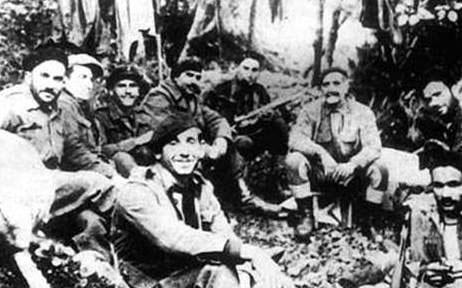

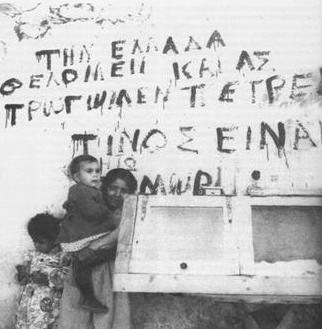

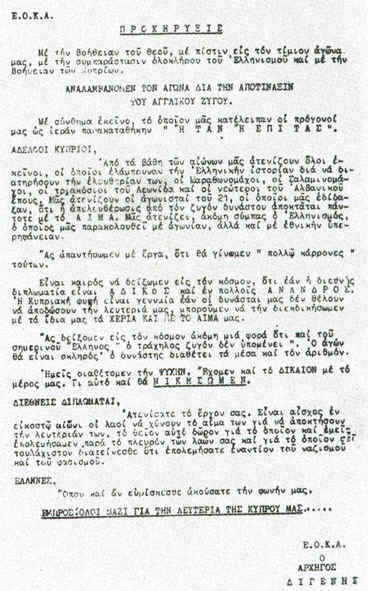
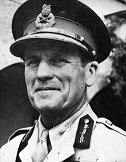
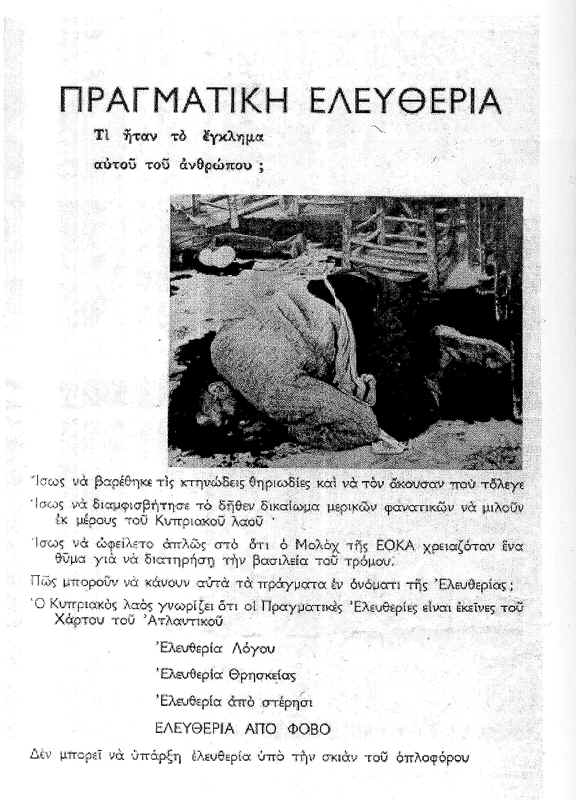
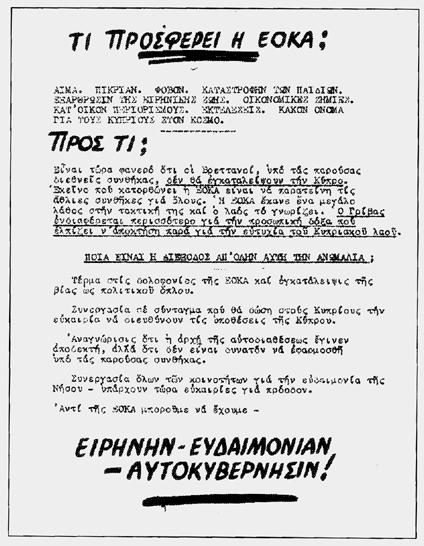
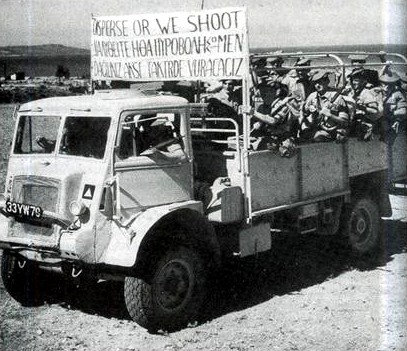
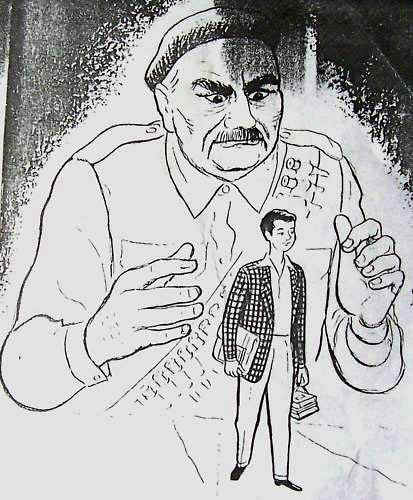
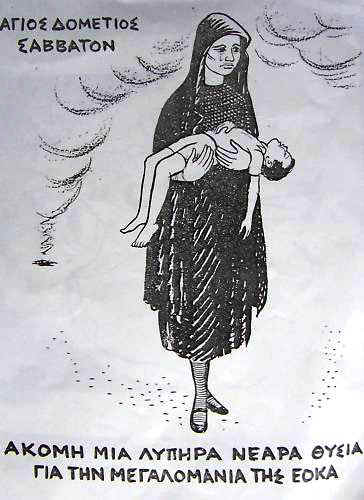
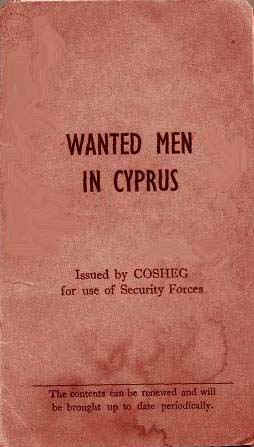
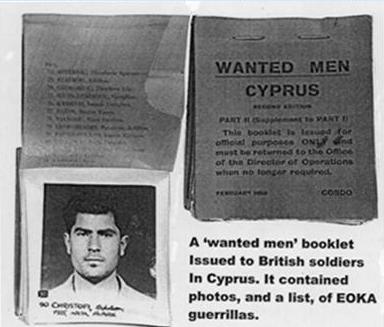
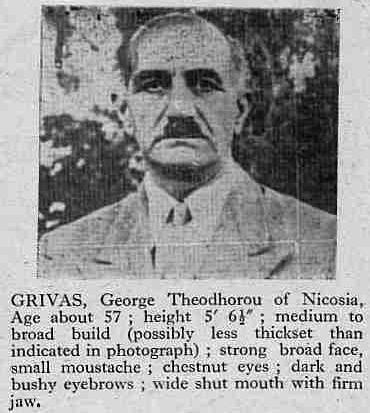
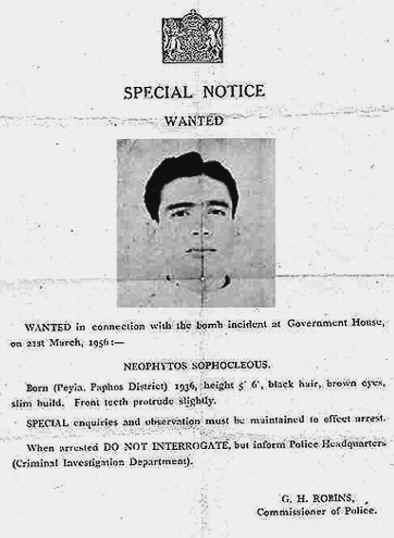
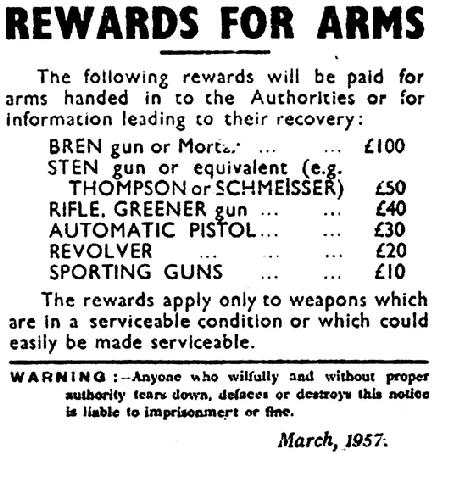
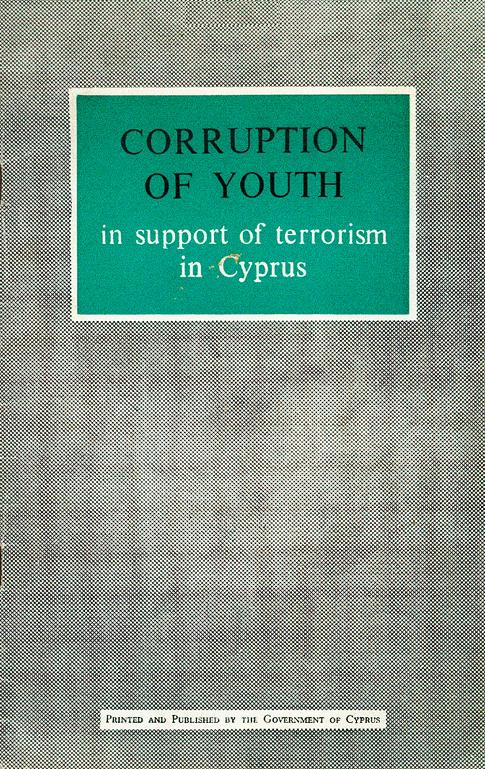
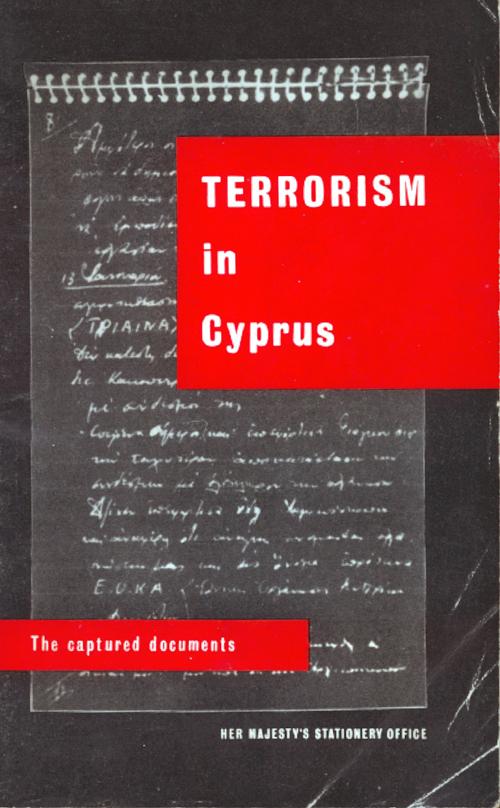
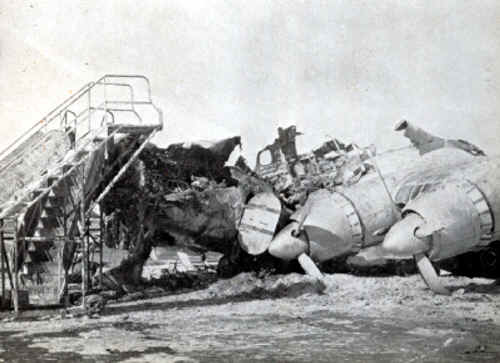
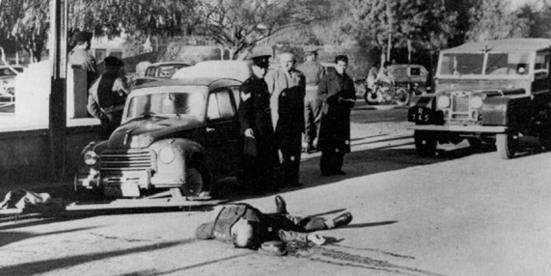
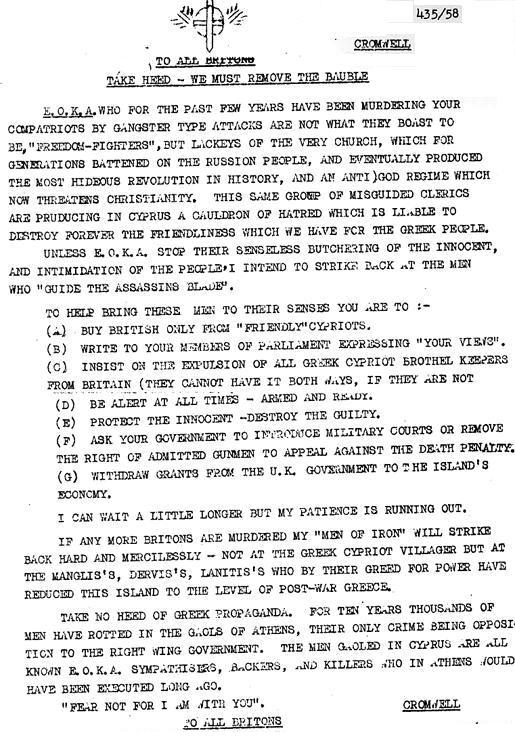
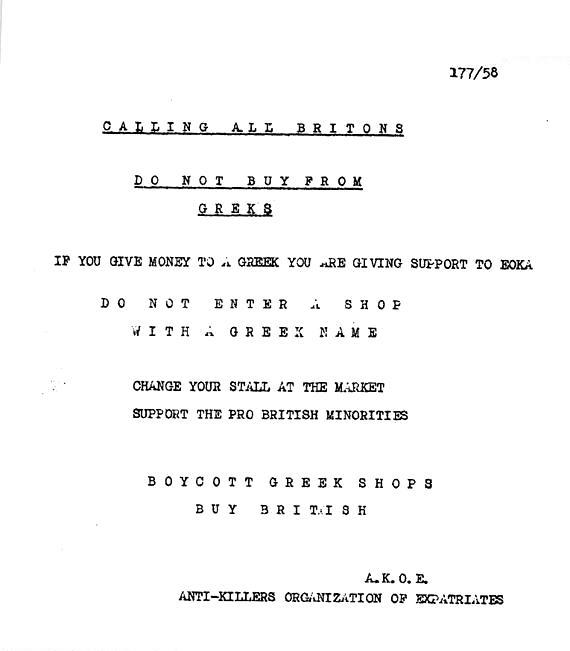
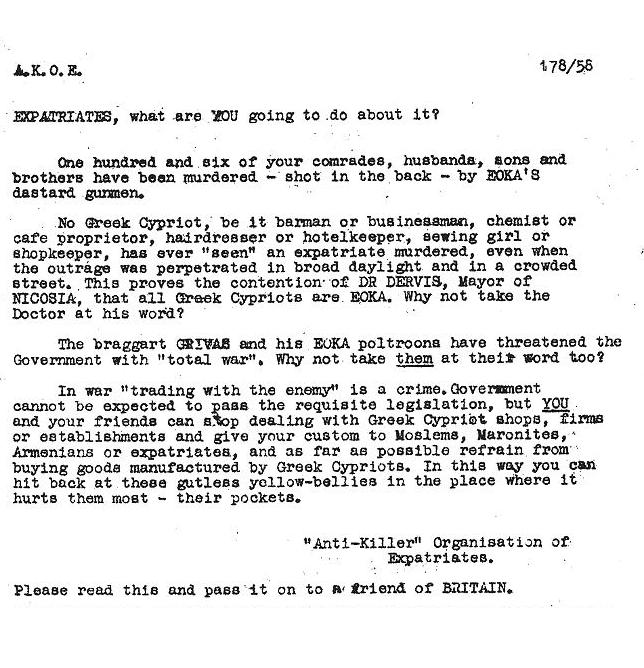
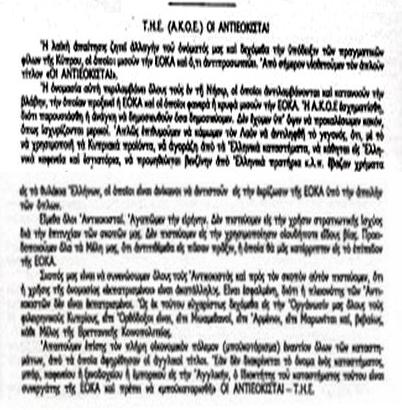
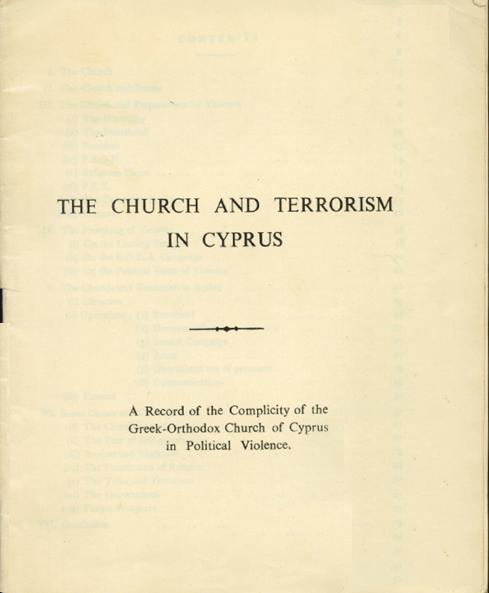
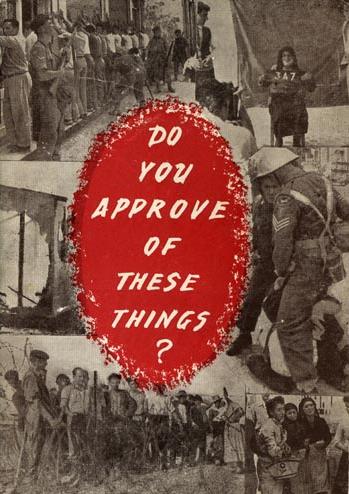
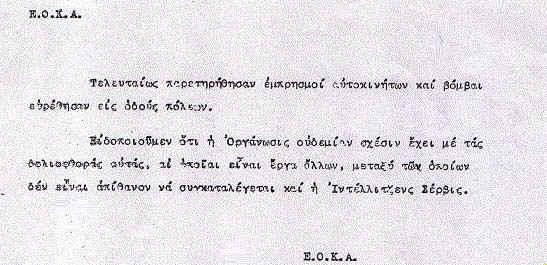
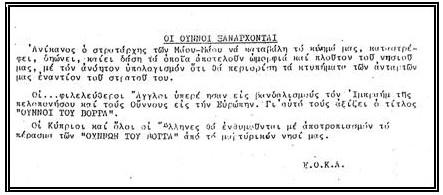

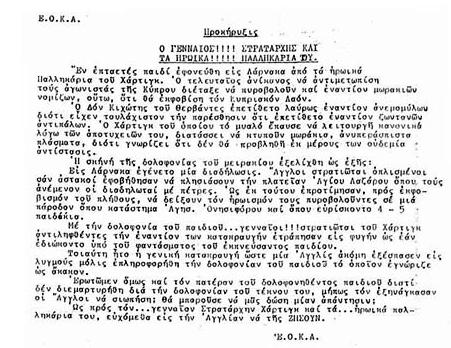
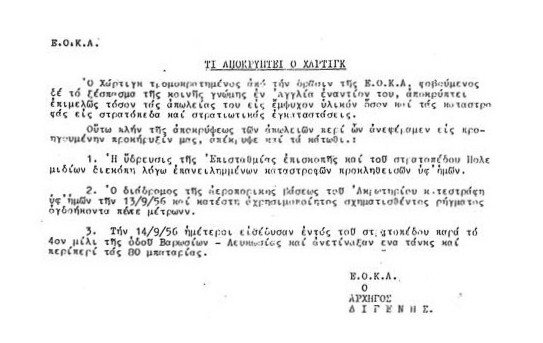
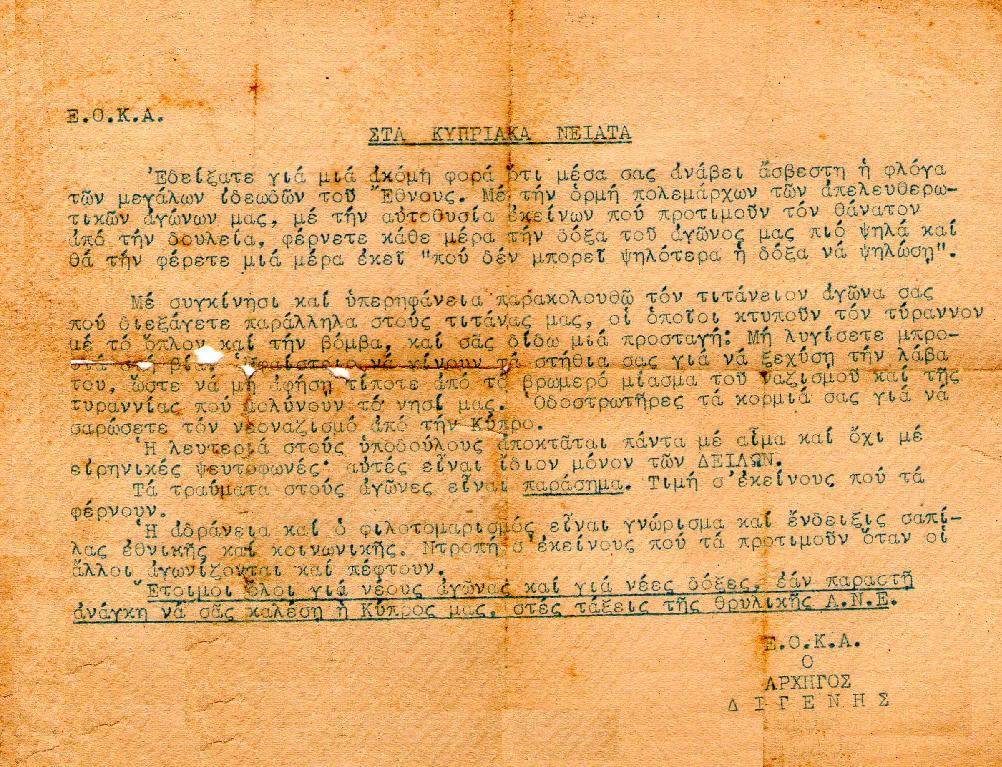
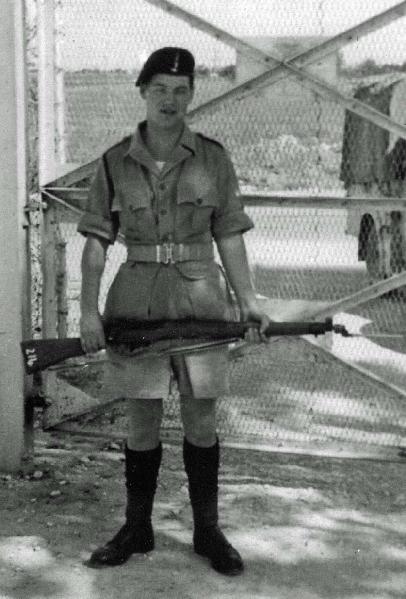
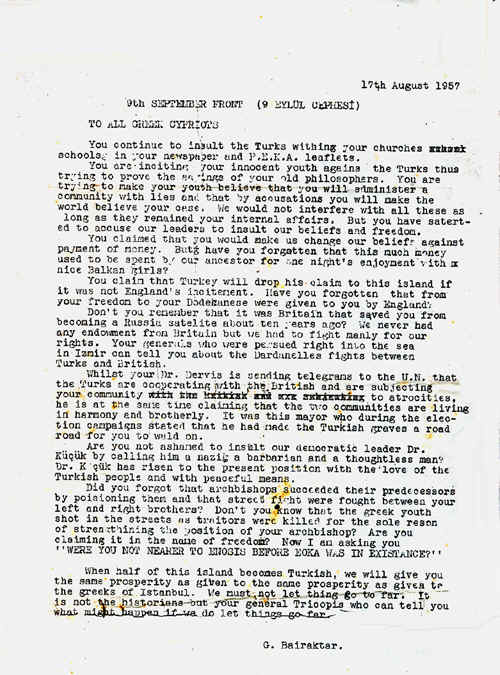
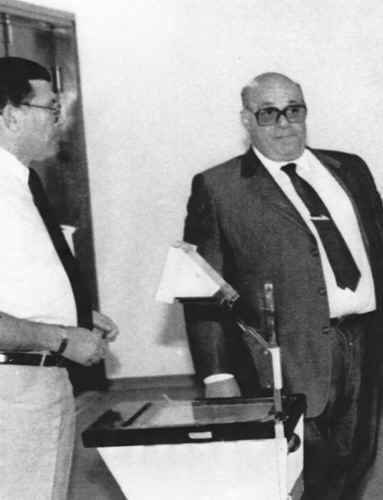
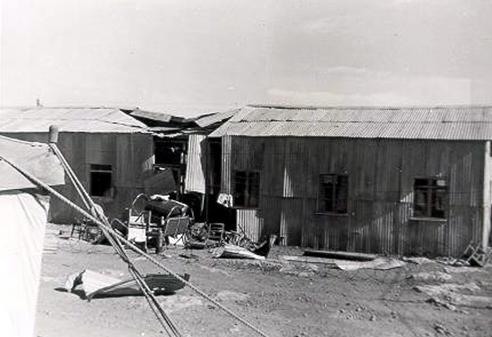
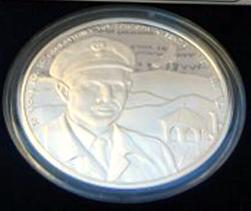
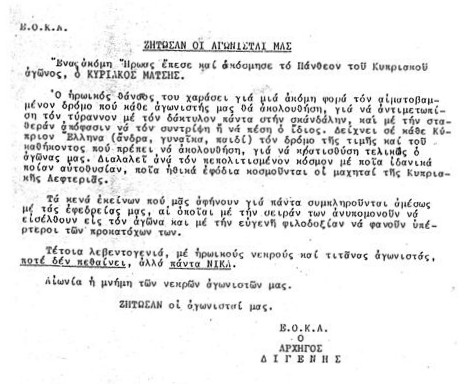
No comments:
Post a Comment